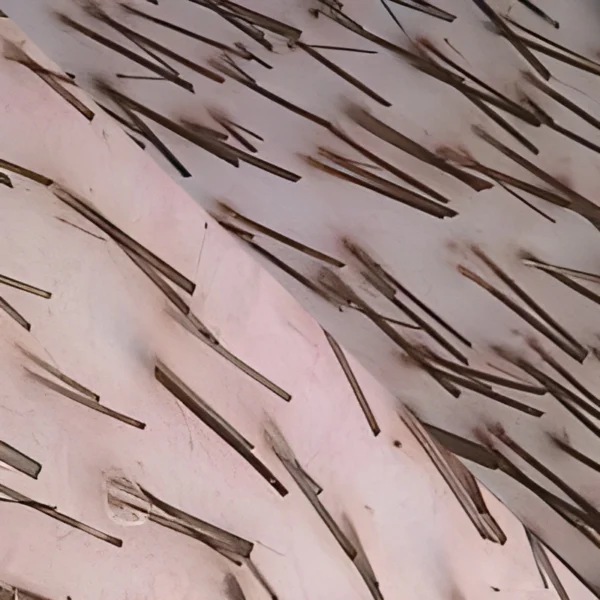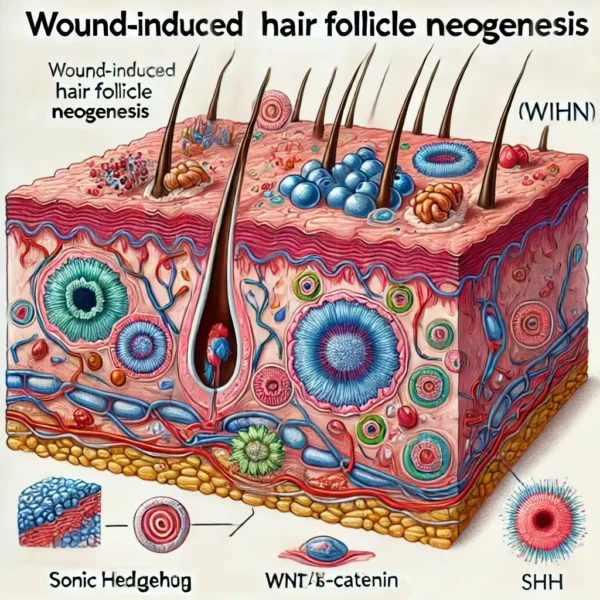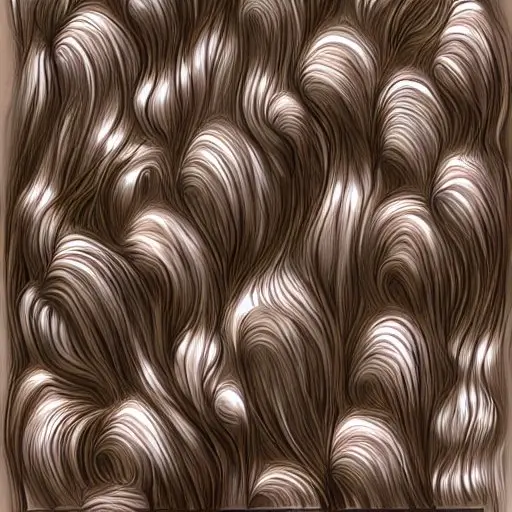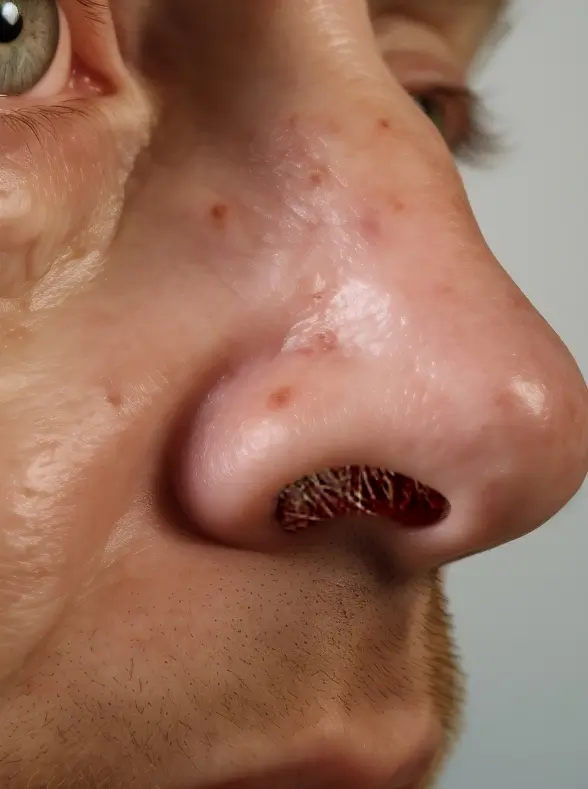When people talk about “thick” or “thin” hair, they are usually describing hair density – that is, the number of visible hair shafts emerging from a given area of scalp, usually expressed as hairs per square centimetre (hairs/cm²). In healthy adults without balding, modern studies most often report average scalp densities between roughly 150 and just over 200 hairs/cm², though older literature and lay sources commonly cite 200–300 hairs/cm². These differences reflect who was studied, where on the scalp they were measured, and which tool was used to count the hairs.
Hair density vs. hair follicle density, two related but distinct ideas: “Hair density” counts the fibers you can see, while “hair follicle density” refers to the number of follicle structures inside the skin. Because follicles cycle through growth (anagen), regression (catagen) and rest (telogen), not every follicle contains a visible fiber at any single moment. Follicle density is therefore higher than fiber density. Human follicles form during fetal life; after birth, no new follicles are normally created, so the total number can only shrink with scarring disease or miniaturisation. Reviews estimate that humans possess about 2–3 million follicles overall, with ~100,000 on the scalp.
Density varies with age, scalp location, sex, and population background: Density is not uniform across your head. Quantitative work shows the vertex (or crown) region typically carries the most hairs, with temples and parietal areas showing fewer. For example, an in vivo study across five continents found vertex counts roughly double those at the temples, and men showed a modest vertex deficit compared with women. In donor zones used for hair transplantation (usually the occipital scalp), hair density ranges around 124–200 hairs/cm², with 65–85 follicular units (natural groupings of 1–3 hairs) per cm². Recent work confirms that even the traditionally “safe” occipital area can thin in patterned hair loss, albeit more slowly than frontal sites.
What happens from birth to old age: Classical histomorphometric series reported very high follicle densities in newborn scalps, in the order of ~1,100 follicles/cm² – followed by a steady decline to ~600/cm² by the third decade and ~400/cm² in our eighth decade. These numbers stem from thin-section histology, which can overestimate counts because follicles are cut at angles and the same hair follicle may be represented in several sections. Nonetheless, the broad trend is biologically sound: as the child’s head grows in surface area, the fixed number of follicles is spread over a larger field. Contemporary pediatric dermoscopy studies similarly emphasise that children start with high densities and hair caliber that changes rapidly in the first years of life.
How do we actually measure hair density? From plucked hairs to pixels: Earlier investigators literally plucked hairs from a marked circle of scalp (the “trichogram”), then counted anagen and telogen hairs under a microscope. Unit-area trichograms improved standardisation, but they were still laborious and uncomfortable. The phototrichogram – taking magnified photographs of a clipped patch and digitally counting – became popular in the 1990s. One head-to-head study showed that phototrichograms underestimated total hair density (181 vs. 237 hairs/cm²) compared with unit-area counts, but accurately captured non-vellus (terminal) hairs and anagen percentages. Techniques such as TrichoScan integrate dermatoscopic imaging with software to automatically calculate density, growth rate, and diameter distributions. Trichoscopy (handheld or video dermoscopy) has become a routine, non-invasive option in clinics, and reliability studies in alopecia show good concordance with clinical assessments.
Beyond counting hairs: newer quantitative metrics: Density alone doesn’t capture “hair volume.” Hair shaft diameter matters – many fine hairs can look sparser than fewer thick hairs. Cross-section trichometry (CST) aggregates both number and calibre into a single “hair mass” number, offering a quick bedside index of fullness. Another useful metric is “hair diameter diversity”: in androgenetic alopecia, a ≥20% variability in shaft diameter within a patch is diagnostic of miniaturisation. A 2024 validation study confirmed that this 20% threshold holds up statistically when measured by phototrichogram.
Artificial intelligence and 3D imaging are pushing precision forward: Non-invasive imaging modalities – optical coherence tomography (OCT), reflectance confocal microscopy (RCM), and high-frequency ultrasound – allow near-histological visualisation of follicles and can even map their angle under the skin, which matters for surgery. A 2020 Laser Surgery and Medicine study coupled OCT with deep learning to automatically count follicles in alopecia patients. A 2024 systematic review catalogued these scalp imaging tools, noting that evidence is growing but standardization and accessibility still remain challenges.
Population and hair-type differences: more than colour alone: It’s tempting to say “blondes have more hairs,” but newer, globally representative datasets tell a more nuanced story. Caucasian cohorts tend to show higher total hair densities than African groups, while Asian hair often has the thickest diameter and fastest growth but fewer follicles per cm². A recent analysis of long scalp hair evolution in humans reported densities between 153 and 208 hairs/cm² alongside growth rates of approximately 0.27–0.43 mm/day, again emphasizing a narrower and more method-dependent “normal range” than popular wisdom suggests.
What density means for diagnosing and treating hair loss: Pattern hair loss (androgenetic alopecia) is characterised by a fall in terminal hair density, a rise in miniaturised hairs, and increased shaft diameter variability. Tools like trichoscopy detect these shifts early. Clinicians also look for regional patterns: for instance, the parietal scalp may be more affected than previously appreciated in female pattern loss, while the occipital region, once thought “immune”, can still show subtle thinning. Because density varies naturally with site, age and ancestry, clinicians increasingly argue that population- and region-specific reference values should replace “one-size-fits-all” ranges.
Hair density is dynamic, daily shedding and cycling matter: Each follicle cycles independently, so density in a small patch fluctuates as different follicles rest or regrow. Classic work mapped the periodicity of growth and shedding, revealing that even in normal scalps, the proportion of hairs in anagen vs. telogen changes with age and body region. Seasonal and hormonal influences add further noise. That means a single measurement is a snapshot; it’s useful, but best interpreted alongside serial images, diameter metrics and clinical context.
Why transplant surgeons care about follicular unit density, not just hair counts: Surgeons harvest and implant follicular units (FUs), not isolated hairs. The typical occipital scalp offers 65–85 FUs/cm², each carrying one to three hairs on average. Planning a transplant involves balancing donor availability, recipient area size, and cosmetic goals. Simply transplanting “more hairs” is not always better: the direction, hair fiber caliber, and grouping affect how full the result looks.
Looking ahead: can we restore density by creating new follicles: For people with advanced scarring alopecias or depleted donor areas, replacing lost follicles is the holy grail. Tissue engineers are experimenting with organoids and 3D-printed moulds to coax human cells into follicle-like structures in skin constructs. While promising, such follicles are not yet ready for routine clinical use.
Take-home messages: Hair density is a complex area of research, and some of the arguments are still active, however, there are some basic conclusions.
Hair density is a number, but the “look” of scalp hair fullness depends just as much on hair diameter and how follicles are grouped together. Normal density ranges are wide and method-dependent; modern averages often sit closer to 150–220 hairs/cm² rather than the oft-quoted 300. Hair density falls as we age – not because follicles stop working, but because they miniaturize, cycle differently, or are simply more spread out over a bigger scalp. For anyone concerned about thinning, meaningful measurements (trichoscopy, phototrichogram, CST) and trend monitoring over time are more informative than a single number. Emerging imaging and AI tools may soon give patients and clinicians more precise, painless ways to track density and follicle health. By understanding how density is defined, measured and naturally variable, it becomes easier to interpret hair changes – and to appreciate why experts rarely rely on one measurement, one number, or one photograph to judge the state of a person’s hair.
Bibliography
11711645 {11711645:UXVVRKJD},{11711645:3H2WC9I9},{11711645:UDRQKZT2},{11711645:VYRA6L4N},{11711645:7JLS4EIF},{11711645:L98IHGIJ},{11711645:LNTDAJP8},{11711645:YLFU95J2},{11711645:AHISBHAI},{11711645:TPGHD68H},{11711645:EFX3T44K},{11711645:IALS3F25},{11711645:5E5QJWMD},{11711645:KEJVH9NM},{11711645:62E9FJ6K},{11711645:MFPMQ7UL},{11711645:PVX3P2M4},{11711645:I53MRBXQ},{11711645:RAKNWS2N},{11711645:TF35AX6E},{11711645:ENY4VZ6U},{11711645:CTUMMFP5},{11711645:4JCKWPEI},{11711645:7RLSHRB4},{11711645:6RS69SXT} 1 vancouver 50 date asc 1894 https://www.keratin.com/wp-content/plugins/zotpress/ %7B%22status%22%3A%22success%22%2C%22updateneeded%22%3Afalse%2C%22instance%22%3Afalse%2C%22meta%22%3A%7B%22request_last%22%3A0%2C%22request_next%22%3A0%2C%22used_cache%22%3Atrue%7D%2C%22data%22%3A%5B%7B%22key%22%3A%22UXVVRKJD%22%2C%22library%22%3A%7B%22id%22%3A11711645%7D%2C%22meta%22%3A%7B%22creatorSummary%22%3A%22Giacometti%22%2C%22parsedDate%22%3A%221965%22%2C%22numChildren%22%3A0%7D%2C%22bib%22%3A%22%26lt%3Bdiv%20class%3D%26quot%3Bcsl-bib-body%26quot%3B%20style%3D%26quot%3Bline-height%3A%201.35%3B%20%26quot%3B%26gt%3B%5Cn%20%20%26lt%3Bdiv%20class%3D%26quot%3Bcsl-entry%26quot%3B%20style%3D%26quot%3Bclear%3A%20left%3B%20%26quot%3B%26gt%3B%5Cn%20%20%20%20%26lt%3Bdiv%20class%3D%26quot%3Bcsl-left-margin%26quot%3B%20style%3D%26quot%3Bfloat%3A%20left%3B%20padding-right%3A%200.5em%3B%20text-align%3A%20right%3B%20width%3A%201em%3B%26quot%3B%26gt%3B1.%26lt%3B%5C%2Fdiv%26gt%3B%26lt%3Bdiv%20class%3D%26quot%3Bcsl-right-inline%26quot%3B%20style%3D%26quot%3Bmargin%3A%200%20.4em%200%201.5em%3B%26quot%3B%26gt%3BGiacometti%20L.%20The%20anatomy%20of%20human%20scalp.%20Advances%20in%20the%20Biology%20of%20Skin.%201965%3B6%3A97%26%23x2013%3B120.%26lt%3B%5C%2Fdiv%26gt%3B%5Cn%20%20%20%26lt%3B%5C%2Fdiv%26gt%3B%5Cn%26lt%3B%5C%2Fdiv%26gt%3B%22%2C%22data%22%3A%7B%22itemType%22%3A%22journalArticle%22%2C%22title%22%3A%22The%20anatomy%20of%20human%20scalp%22%2C%22creators%22%3A%5B%7B%22creatorType%22%3A%22author%22%2C%22firstName%22%3A%22L%22%2C%22lastName%22%3A%22Giacometti%22%7D%5D%2C%22abstractNote%22%3A%22%22%2C%22date%22%3A%221965%22%2C%22language%22%3A%22%22%2C%22DOI%22%3A%22%22%2C%22ISSN%22%3A%22%22%2C%22url%22%3A%22%22%2C%22collections%22%3A%5B%22BISVZ778%22%5D%2C%22dateModified%22%3A%222025-07-24T16%3A38%3A58Z%22%7D%7D%2C%7B%22key%22%3A%22KEJVH9NM%22%2C%22library%22%3A%7B%22id%22%3A11711645%7D%2C%22meta%22%3A%7B%22creatorSummary%22%3A%22Barman%20et%20al.%22%2C%22parsedDate%22%3A%221965-04%22%2C%22numChildren%22%3A0%7D%2C%22bib%22%3A%22%26lt%3Bdiv%20class%3D%26quot%3Bcsl-bib-body%26quot%3B%20style%3D%26quot%3Bline-height%3A%201.35%3B%20%26quot%3B%26gt%3B%5Cn%20%20%26lt%3Bdiv%20class%3D%26quot%3Bcsl-entry%26quot%3B%20style%3D%26quot%3Bclear%3A%20left%3B%20%26quot%3B%26gt%3B%5Cn%20%20%20%20%26lt%3Bdiv%20class%3D%26quot%3Bcsl-left-margin%26quot%3B%20style%3D%26quot%3Bfloat%3A%20left%3B%20padding-right%3A%200.5em%3B%20text-align%3A%20right%3B%20width%3A%201em%3B%26quot%3B%26gt%3B1.%26lt%3B%5C%2Fdiv%26gt%3B%26lt%3Bdiv%20class%3D%26quot%3Bcsl-right-inline%26quot%3B%20style%3D%26quot%3Bmargin%3A%200%20.4em%200%201.5em%3B%26quot%3B%26gt%3BBarman%20JM%2C%20Astore%20I%2C%20Pecoraro%20V.%20The%20normal%20trichogram%20of%20the%20adult.%20J%20Invest%20Dermatol.%201965%20Apr%3B44%3A233%26%23x2013%3B6.%26lt%3B%5C%2Fdiv%26gt%3B%5Cn%20%20%20%26lt%3B%5C%2Fdiv%26gt%3B%5Cn%26lt%3B%5C%2Fdiv%26gt%3B%22%2C%22data%22%3A%7B%22itemType%22%3A%22journalArticle%22%2C%22title%22%3A%22The%20normal%20trichogram%20of%20the%20adult%22%2C%22creators%22%3A%5B%7B%22creatorType%22%3A%22author%22%2C%22firstName%22%3A%22J.%20M.%22%2C%22lastName%22%3A%22Barman%22%7D%2C%7B%22creatorType%22%3A%22author%22%2C%22firstName%22%3A%22I.%22%2C%22lastName%22%3A%22Astore%22%7D%2C%7B%22creatorType%22%3A%22author%22%2C%22firstName%22%3A%22V.%22%2C%22lastName%22%3A%22Pecoraro%22%7D%5D%2C%22abstractNote%22%3A%22%22%2C%22date%22%3A%221965-04%22%2C%22language%22%3A%22eng%22%2C%22DOI%22%3A%2210.1038%5C%2Fjid.1965.42%22%2C%22ISSN%22%3A%220022-202X%22%2C%22url%22%3A%22%22%2C%22collections%22%3A%5B%22BISVZ778%22%5D%2C%22dateModified%22%3A%222025-07-24T15%3A57%3A46Z%22%7D%7D%2C%7B%22key%22%3A%22L98IHGIJ%22%2C%22library%22%3A%7B%22id%22%3A11711645%7D%2C%22meta%22%3A%7B%22creatorSummary%22%3A%22Saitoh%20et%20al.%22%2C%22parsedDate%22%3A%221970-01%22%2C%22numChildren%22%3A0%7D%2C%22bib%22%3A%22%26lt%3Bdiv%20class%3D%26quot%3Bcsl-bib-body%26quot%3B%20style%3D%26quot%3Bline-height%3A%201.35%3B%20%26quot%3B%26gt%3B%5Cn%20%20%26lt%3Bdiv%20class%3D%26quot%3Bcsl-entry%26quot%3B%20style%3D%26quot%3Bclear%3A%20left%3B%20%26quot%3B%26gt%3B%5Cn%20%20%20%20%26lt%3Bdiv%20class%3D%26quot%3Bcsl-left-margin%26quot%3B%20style%3D%26quot%3Bfloat%3A%20left%3B%20padding-right%3A%200.5em%3B%20text-align%3A%20right%3B%20width%3A%201em%3B%26quot%3B%26gt%3B1.%26lt%3B%5C%2Fdiv%26gt%3B%26lt%3Bdiv%20class%3D%26quot%3Bcsl-right-inline%26quot%3B%20style%3D%26quot%3Bmargin%3A%200%20.4em%200%201.5em%3B%26quot%3B%26gt%3BSaitoh%20M%2C%20Uzuka%20M%2C%20Sakamoto%20M.%20Human%20hair%20cycle.%20J%20Invest%20Dermatol.%201970%20Jan%3B54%281%29%3A65%26%23x2013%3B81.%26lt%3B%5C%2Fdiv%26gt%3B%5Cn%20%20%20%26lt%3B%5C%2Fdiv%26gt%3B%5Cn%26lt%3B%5C%2Fdiv%26gt%3B%22%2C%22data%22%3A%7B%22itemType%22%3A%22journalArticle%22%2C%22title%22%3A%22Human%20hair%20cycle%22%2C%22creators%22%3A%5B%7B%22creatorType%22%3A%22author%22%2C%22firstName%22%3A%22M.%22%2C%22lastName%22%3A%22Saitoh%22%7D%2C%7B%22creatorType%22%3A%22author%22%2C%22firstName%22%3A%22M.%22%2C%22lastName%22%3A%22Uzuka%22%7D%2C%7B%22creatorType%22%3A%22author%22%2C%22firstName%22%3A%22M.%22%2C%22lastName%22%3A%22Sakamoto%22%7D%5D%2C%22abstractNote%22%3A%22%22%2C%22date%22%3A%221970-01%22%2C%22language%22%3A%22eng%22%2C%22DOI%22%3A%2210.1111%5C%2F1523-1747.ep12551679%22%2C%22ISSN%22%3A%220022-202X%22%2C%22url%22%3A%22%22%2C%22collections%22%3A%5B%22BISVZ778%22%5D%2C%22dateModified%22%3A%222025-07-24T16%3A09%3A04Z%22%7D%7D%2C%7B%22key%22%3A%22MFPMQ7UL%22%2C%22library%22%3A%7B%22id%22%3A11711645%7D%2C%22meta%22%3A%7B%22creatorSummary%22%3A%22Hess%20et%20al.%22%2C%22parsedDate%22%3A%221990-06%22%2C%22numChildren%22%3A0%7D%2C%22bib%22%3A%22%26lt%3Bdiv%20class%3D%26quot%3Bcsl-bib-body%26quot%3B%20style%3D%26quot%3Bline-height%3A%201.35%3B%20%26quot%3B%26gt%3B%5Cn%20%20%26lt%3Bdiv%20class%3D%26quot%3Bcsl-entry%26quot%3B%20style%3D%26quot%3Bclear%3A%20left%3B%20%26quot%3B%26gt%3B%5Cn%20%20%20%20%26lt%3Bdiv%20class%3D%26quot%3Bcsl-left-margin%26quot%3B%20style%3D%26quot%3Bfloat%3A%20left%3B%20padding-right%3A%200.5em%3B%20text-align%3A%20right%3B%20width%3A%201em%3B%26quot%3B%26gt%3B1.%26lt%3B%5C%2Fdiv%26gt%3B%26lt%3Bdiv%20class%3D%26quot%3Bcsl-right-inline%26quot%3B%20style%3D%26quot%3Bmargin%3A%200%20.4em%200%201.5em%3B%26quot%3B%26gt%3BHess%20WM%2C%20Seegmiller%20RE%2C%20Gardner%20JS%2C%20Allen%20JV%2C%20Barendregt%20S.%20Human%20hair%20morphology%3A%20a%20scanning%20electron%20microscopy%20study%20on%20a%20male%20Caucasoid%20and%20a%20computerized%20classification%20of%20regional%20differences.%20Scanning%20Microsc.%201990%20June%3B4%282%29%3A375%26%23x2013%3B86.%26lt%3B%5C%2Fdiv%26gt%3B%5Cn%20%20%20%26lt%3B%5C%2Fdiv%26gt%3B%5Cn%26lt%3B%5C%2Fdiv%26gt%3B%22%2C%22data%22%3A%7B%22itemType%22%3A%22journalArticle%22%2C%22title%22%3A%22Human%20hair%20morphology%3A%20a%20scanning%20electron%20microscopy%20study%20on%20a%20male%20Caucasoid%20and%20a%20computerized%20classification%20of%20regional%20differences%22%2C%22creators%22%3A%5B%7B%22creatorType%22%3A%22author%22%2C%22firstName%22%3A%22W.%20M.%22%2C%22lastName%22%3A%22Hess%22%7D%2C%7B%22creatorType%22%3A%22author%22%2C%22firstName%22%3A%22R.%20E.%22%2C%22lastName%22%3A%22Seegmiller%22%7D%2C%7B%22creatorType%22%3A%22author%22%2C%22firstName%22%3A%22J.%20S.%22%2C%22lastName%22%3A%22Gardner%22%7D%2C%7B%22creatorType%22%3A%22author%22%2C%22firstName%22%3A%22J.%20V.%22%2C%22lastName%22%3A%22Allen%22%7D%2C%7B%22creatorType%22%3A%22author%22%2C%22firstName%22%3A%22S.%22%2C%22lastName%22%3A%22Barendregt%22%7D%5D%2C%22abstractNote%22%3A%22The%20present%20study%20was%20performed%20to%20provide%20a%20better%20understanding%20of%20the%20morphological%20variations%20of%20mammalian%20hair.%20Terminal%20hair%20samples%20were%20obtained%20from%20different%20regions%20of%20the%20body%20of%20the%20same%20Caucasian%20male.%20All%20hair%20samples%20were%20either%20cleaned%20or%20treated%20before%20being%20examined%20with%20scanning%20electron%20microscopy.%20As%20human%20scalp%20hair%20grew%20it%20appeared%20small%20like%20lanugo%20hair%2C%20but%20the%20increase%20in%20diameter%20appeared%20to%20have%20been%20relatively%20rapid.%20As%20hair%20increased%20in%20diameter%20the%20appearance%20of%20the%20scales%20changed.%20Neck%20hair%20was%20slightly%20smaller%20in%20diameter%20than%20scalp%20hair%2C%20and%20axillary%20hair%20was%20slightly%20smaller%20in%20diameter%20than%20neck%20hair.%20Nostril%20hair%20was%20larger%20than%20scalp%20or%20axillary%20hair.%20Eyelash%20hair%20was%20much%20smaller%20and%20much%20shorter%20than%20eyebrow%20hair.%20Neck%20hair%2C%20forearm%20hair%2C%20and%20shin%20hair%20were%20smaller%20than%20hair%20from%20most%20other%20regions%20of%20the%20body.%20Chest%20hair%20was%20similar%20in%20size%20to%20scalp%20hair%2C%20and%20pubic%20and%20sideburn%20hair%20were%20larger%20than%20scalp%20hair.%20A%20morphological%20feature%20called%20%26quot%3Bsteak-boning%26quot%3B%20was%20more%20characteristically%20present%20in%20whiskers%20of%20Caucasoids%20than%20Orientals%20or%20Blacks.%20%26quot%3BSteak-boning%26quot%3B%20occurred%20most%20frequently%20in%20hair%20of%20the%20mustache%2C%20followed%20by%20that%20of%20the%20chin%2C%20sideburn%2C%20cheek%20and%20under%20the%20chin.%20Cut%20surfaces%20of%20whiskers%20were%20different%20for%20electric%20as%20compared%20with%20straightedge%20razors.%20Hair%20morphology%20varied%20relative%20to%20the%20body%20region.%20Computer%20analysis%20of%20resin-embedded%20hair%20made%20it%20possible%20to%20classify%20arm%2C%20mustache%2C%20cheek%2C%20chin%2C%20head%2C%20shin%2C%20and%20pubic%20hair%2C%20and%20to%20quantify%20cross-sectioned%20differences.%22%2C%22date%22%3A%221990-06%22%2C%22language%22%3A%22eng%22%2C%22DOI%22%3A%22%22%2C%22ISSN%22%3A%220891-7035%22%2C%22url%22%3A%22%22%2C%22collections%22%3A%5B%22BISVZ778%22%5D%2C%22dateModified%22%3A%222025-07-24T15%3A54%3A20Z%22%7D%7D%2C%7B%22key%22%3A%223H2WC9I9%22%2C%22library%22%3A%7B%22id%22%3A11711645%7D%2C%22meta%22%3A%7B%22creatorSummary%22%3A%22Hayashi%20et%20al.%22%2C%22parsedDate%22%3A%221991-08%22%2C%22numChildren%22%3A0%7D%2C%22bib%22%3A%22%26lt%3Bdiv%20class%3D%26quot%3Bcsl-bib-body%26quot%3B%20style%3D%26quot%3Bline-height%3A%201.35%3B%20%26quot%3B%26gt%3B%5Cn%20%20%26lt%3Bdiv%20class%3D%26quot%3Bcsl-entry%26quot%3B%20style%3D%26quot%3Bclear%3A%20left%3B%20%26quot%3B%26gt%3B%5Cn%20%20%20%20%26lt%3Bdiv%20class%3D%26quot%3Bcsl-left-margin%26quot%3B%20style%3D%26quot%3Bfloat%3A%20left%3B%20padding-right%3A%200.5em%3B%20text-align%3A%20right%3B%20width%3A%201em%3B%26quot%3B%26gt%3B1.%26lt%3B%5C%2Fdiv%26gt%3B%26lt%3Bdiv%20class%3D%26quot%3Bcsl-right-inline%26quot%3B%20style%3D%26quot%3Bmargin%3A%200%20.4em%200%201.5em%3B%26quot%3B%26gt%3BHayashi%20S%2C%20Miyamoto%20I%2C%20Takeda%20K.%20Measurement%20of%20human%20hair%20growth%20by%20optical%20microscopy%20and%20image%20analysis.%20Br%20J%20Dermatol.%201991%20Aug%3B125%282%29%3A123%26%23x2013%3B9.%26lt%3B%5C%2Fdiv%26gt%3B%5Cn%20%20%20%26lt%3B%5C%2Fdiv%26gt%3B%5Cn%26lt%3B%5C%2Fdiv%26gt%3B%22%2C%22data%22%3A%7B%22itemType%22%3A%22journalArticle%22%2C%22title%22%3A%22Measurement%20of%20human%20hair%20growth%20by%20optical%20microscopy%20and%20image%20analysis%22%2C%22creators%22%3A%5B%7B%22creatorType%22%3A%22author%22%2C%22firstName%22%3A%22S.%22%2C%22lastName%22%3A%22Hayashi%22%7D%2C%7B%22creatorType%22%3A%22author%22%2C%22firstName%22%3A%22I.%22%2C%22lastName%22%3A%22Miyamoto%22%7D%2C%7B%22creatorType%22%3A%22author%22%2C%22firstName%22%3A%22K.%22%2C%22lastName%22%3A%22Takeda%22%7D%5D%2C%22abstractNote%22%3A%22We%20have%20developed%20a%20quantitative%20method%20for%20measuring%20hair%20growth%20using%20optical%20microscopy%20and%20image%20analysis%2C%20and%20have%20used%20this%20to%20investigate%20the%20rate%20of%20growth%20in%20subjects%20with%20and%20without%20alopecia.%20The%20hairs%20were%20cut%20from%20an%20area%207-8%20mm%20in%20diameter%20and%2024%20h%20and%2072%20h%20later%2C%20images%20of%20the%20areas%20were%20obtained%20using%20an%20optical%20microscope%20and%20were%20recorded%20on%20a%20video%20disc.%20Measurements%20of%20the%20regrowing%20hairs%2C%20placed%20parallel%20to%20the%20scalp%20using%20a%20glass%20slide%20attached%20to%20the%20front%20of%20the%20microscope%2C%20were%20made%20using%20the%20image%20analyser.%20In%20subjects%20with%20little%20or%20no%20baldness%20there%20was%20a%20clear%20difference%20between%20fast-growing%20hairs%20and%20resting%20or%20slow-growing%20hairs.%20However%2C%20in%20subjects%20with%20alopecia%20there%20was%20no%20such%20difference%20and%20the%20growth%20rate%20of%20all%20the%20hairs%20showed%20a%20continuous%20distribution.%20Using%20this%20method%20other%20parameters%20such%20as%20the%20number%20of%20hairs%20per%20unit%20area%20and%20hair%20diameter%20as%20well%20as%20grouping%20of%20the%20hairs%20could%20be%20measured.%22%2C%22date%22%3A%221991-08%22%2C%22language%22%3A%22eng%22%2C%22DOI%22%3A%2210.1111%5C%2Fj.1365-2133.1991.tb06058.x%22%2C%22ISSN%22%3A%220007-0963%22%2C%22url%22%3A%22%22%2C%22collections%22%3A%5B%22BISVZ778%22%5D%2C%22dateModified%22%3A%222025-07-24T16%3A11%3A03Z%22%7D%7D%2C%7B%22key%22%3A%226RS69SXT%22%2C%22library%22%3A%7B%22id%22%3A11711645%7D%2C%22meta%22%3A%7B%22creatorSummary%22%3A%22Rushton%20et%20al.%22%2C%22parsedDate%22%3A%221993-04%22%2C%22numChildren%22%3A0%7D%2C%22bib%22%3A%22%26lt%3Bdiv%20class%3D%26quot%3Bcsl-bib-body%26quot%3B%20style%3D%26quot%3Bline-height%3A%201.35%3B%20%26quot%3B%26gt%3B%5Cn%20%20%26lt%3Bdiv%20class%3D%26quot%3Bcsl-entry%26quot%3B%20style%3D%26quot%3Bclear%3A%20left%3B%20%26quot%3B%26gt%3B%5Cn%20%20%20%20%26lt%3Bdiv%20class%3D%26quot%3Bcsl-left-margin%26quot%3B%20style%3D%26quot%3Bfloat%3A%20left%3B%20padding-right%3A%200.5em%3B%20text-align%3A%20right%3B%20width%3A%201em%3B%26quot%3B%26gt%3B1.%26lt%3B%5C%2Fdiv%26gt%3B%26lt%3Bdiv%20class%3D%26quot%3Bcsl-right-inline%26quot%3B%20style%3D%26quot%3Bmargin%3A%200%20.4em%200%201.5em%3B%26quot%3B%26gt%3BRushton%20DH%2C%20de%20Brouwer%20B%2C%20de%20Coster%20W%2C%20van%20Neste%20DJ.%20Comparative%20evaluation%20of%20scalp%20hair%20by%20phototrichogram%20and%20unit%20area%20trichogram%20analysis%20within%20the%20same%20subjects.%20Acta%20Derm%20Venereol.%201993%20Apr%3B73%282%29%3A150%26%23x2013%3B3.%26lt%3B%5C%2Fdiv%26gt%3B%5Cn%20%20%20%26lt%3B%5C%2Fdiv%26gt%3B%5Cn%26lt%3B%5C%2Fdiv%26gt%3B%22%2C%22data%22%3A%7B%22itemType%22%3A%22journalArticle%22%2C%22title%22%3A%22Comparative%20evaluation%20of%20scalp%20hair%20by%20phototrichogram%20and%20unit%20area%20trichogram%20analysis%20within%20the%20same%20subjects%22%2C%22creators%22%3A%5B%7B%22creatorType%22%3A%22author%22%2C%22firstName%22%3A%22D.%20H.%22%2C%22lastName%22%3A%22Rushton%22%7D%2C%7B%22creatorType%22%3A%22author%22%2C%22firstName%22%3A%22B.%22%2C%22lastName%22%3A%22de%20Brouwer%22%7D%2C%7B%22creatorType%22%3A%22author%22%2C%22firstName%22%3A%22W.%22%2C%22lastName%22%3A%22de%20Coster%22%7D%2C%7B%22creatorType%22%3A%22author%22%2C%22firstName%22%3A%22D.%20J.%22%2C%22lastName%22%3A%22van%20Neste%22%7D%5D%2C%22abstractNote%22%3A%22Quantitative%20evaluation%20of%20scalp%20hair%20requires%20techniques%20that%20are%20reproducible.%20The%20unit%20area%20trichogram%20is%20such%20a%20method%20but%20is%20unsuitable%20for%20large-scale%20clinical%20trials.%20An%20alternative%20may%20be%20the%20phototrichogram--a%20non-plucking%2C%20non-invasive%20method.%20Hair%20variables%20were%20evaluated%20in%2012%20Caucasian%20subjects%20employing%20both%20methods.%20The%20mean%20value%20for%20total%20hair%20density%20was%20significantly%20underestimated%20by%20the%20phototrichogram%20%28181%20versus%20237%20hairs%5C%2Fcm2%29%3B%20however%2C%20no%20significant%20difference%20was%20found%20between%20this%20phototrichogram%20value%20and%20the%20number%20of%20non-vellus%20hairs%5C%2Fcm2.%20Estimates%20for%20the%20percentage%20of%20anagen%20hairs%20were%20similar%20with%20both%20methods.%20Hair%20diameters%20from%20the%20phototrichogram%20were%20too%20unreliable%20to%20be%20of%20any%20practical%20use.%20Analysis%20of%20the%20individual%20hair%20data%20revealed%20that%20light%20hair%20was%20much%20more%20difficult%20to%20evaluate%20than%20dark%20hair.%20Consequently%2C%20Caucasian%20subjects%20with%20light%20hair%20or%20dark%20skin%20subjects%20with%20dark%20hair%20should%20be%20excluded%20from%20studies%20employing%20phototrichograms.%22%2C%22date%22%3A%221993-04%22%2C%22language%22%3A%22eng%22%2C%22DOI%22%3A%2210.2340%5C%2F0001555573150153%22%2C%22ISSN%22%3A%220001-5555%22%2C%22url%22%3A%22%22%2C%22collections%22%3A%5B%22BISVZ778%22%5D%2C%22dateModified%22%3A%222025-07-24T15%3A51%3A44Z%22%7D%7D%2C%7B%22key%22%3A%227JLS4EIF%22%2C%22library%22%3A%7B%22id%22%3A11711645%7D%2C%22meta%22%3A%7B%22creatorSummary%22%3A%22Courtois%20et%20al.%22%2C%22parsedDate%22%3A%221996-01%22%2C%22numChildren%22%3A0%7D%2C%22bib%22%3A%22%26lt%3Bdiv%20class%3D%26quot%3Bcsl-bib-body%26quot%3B%20style%3D%26quot%3Bline-height%3A%201.35%3B%20%26quot%3B%26gt%3B%5Cn%20%20%26lt%3Bdiv%20class%3D%26quot%3Bcsl-entry%26quot%3B%20style%3D%26quot%3Bclear%3A%20left%3B%20%26quot%3B%26gt%3B%5Cn%20%20%20%20%26lt%3Bdiv%20class%3D%26quot%3Bcsl-left-margin%26quot%3B%20style%3D%26quot%3Bfloat%3A%20left%3B%20padding-right%3A%200.5em%3B%20text-align%3A%20right%3B%20width%3A%201em%3B%26quot%3B%26gt%3B1.%26lt%3B%5C%2Fdiv%26gt%3B%26lt%3Bdiv%20class%3D%26quot%3Bcsl-right-inline%26quot%3B%20style%3D%26quot%3Bmargin%3A%200%20.4em%200%201.5em%3B%26quot%3B%26gt%3BCourtois%20M%2C%20Loussouarn%20G%2C%20Hourseau%20S%2C%20Grollier%20JF.%20Periodicity%20in%20the%20growth%20and%20shedding%20of%20hair.%20Br%20J%20Dermatol.%201996%20Jan%3B134%281%29%3A47%26%23x2013%3B54.%26lt%3B%5C%2Fdiv%26gt%3B%5Cn%20%20%20%26lt%3B%5C%2Fdiv%26gt%3B%5Cn%26lt%3B%5C%2Fdiv%26gt%3B%22%2C%22data%22%3A%7B%22itemType%22%3A%22journalArticle%22%2C%22title%22%3A%22Periodicity%20in%20the%20growth%20and%20shedding%20of%20hair%22%2C%22creators%22%3A%5B%7B%22creatorType%22%3A%22author%22%2C%22firstName%22%3A%22M.%22%2C%22lastName%22%3A%22Courtois%22%7D%2C%7B%22creatorType%22%3A%22author%22%2C%22firstName%22%3A%22G.%22%2C%22lastName%22%3A%22Loussouarn%22%7D%2C%7B%22creatorType%22%3A%22author%22%2C%22firstName%22%3A%22S.%22%2C%22lastName%22%3A%22Hourseau%22%7D%2C%7B%22creatorType%22%3A%22author%22%2C%22firstName%22%3A%22J.%20F.%22%2C%22lastName%22%3A%22Grollier%22%7D%5D%2C%22abstractNote%22%3A%22Ten%20men%2C%20with%20or%20without%20alopecia%2C%20were%20observed%20for%20a%20period%20of%20between%208%20and%2014%20years%20using%20phototrichograms%20on%20a%20precisely%20located%20zone%20on%20the%20vertex%20of%20the%20scalp.%20Among%20the%20various%20parameters%20observed%2C%20we%20chose%20the%20percentage%20of%20hairs%20in%20telogen%20as%20the%20criterion%20for%20assessment%20of%20hair%20shedding.%20Mathematical%20analysis%20of%20the%20variations%20in%20this%20telogen%20percentage%20was%20carried%20out%20for%20each%20individual%20subject%20and%20for%20the%20whole%20group%2C%20as%20represented%20by%20the%20population%20mean%20%28or%20the%20%26%23039%3Baverage%20subject%26%23039%3B%29.%20This%20analysis%20demonstrated%20the%20existence%20of%20overall%20annual%20periodicity%2C%20manifested%20by%20a%20maximal%20proportion%20of%20telogen%20hairs%20at%20the%20end%20of%20summer%20and%20the%20beginning%20of%20autumn.%20Some%20subjects%20also%20exhibited%20a%20periodicity%20approximately%20corresponding%20to%20two%20annual%20peaks.%20In%20those%20subjects%20with%20a%20very%20low%20proportion%20of%20hairs%20in%20telogen%2C%20no%20periodicity%20was%20demonstrated.%20In%20another%20group%20of%20subjects%2C%20it%20has%20been%20shown%20that%20the%20variations%20in%20telogen%20percentage%20reflect%20those%20observed%20in%20hair%20shedding%2C%20assessed%20in%20a%20standardized%20manner.%20Periodicity%20of%20the%20telogen%20percentage%2C%20and%20hence%20of%20hair%20fall%2C%20is%20not%20independent%20of%20climatic%20factors%20%28sunshine%20hours%29%2C%20and%20these%20must%20be%20taken%20into%20account%20when%20assessing%20the%20treatment%20or%20prevention%20of%20hair%20loss.%22%2C%22date%22%3A%221996-01%22%2C%22language%22%3A%22eng%22%2C%22DOI%22%3A%22%22%2C%22ISSN%22%3A%220007-0963%22%2C%22url%22%3A%22%22%2C%22collections%22%3A%5B%22BISVZ778%22%5D%2C%22dateModified%22%3A%222025-07-24T16%3A09%3A18Z%22%7D%7D%2C%7B%22key%22%3A%22RAKNWS2N%22%2C%22library%22%3A%7B%22id%22%3A11711645%7D%2C%22meta%22%3A%7B%22creatorSummary%22%3A%22Jimenez%20and%20Ruifern%5Cu00e1ndez%22%2C%22parsedDate%22%3A%221999-04%22%2C%22numChildren%22%3A0%7D%2C%22bib%22%3A%22%26lt%3Bdiv%20class%3D%26quot%3Bcsl-bib-body%26quot%3B%20style%3D%26quot%3Bline-height%3A%201.35%3B%20%26quot%3B%26gt%3B%5Cn%20%20%26lt%3Bdiv%20class%3D%26quot%3Bcsl-entry%26quot%3B%20style%3D%26quot%3Bclear%3A%20left%3B%20%26quot%3B%26gt%3B%5Cn%20%20%20%20%26lt%3Bdiv%20class%3D%26quot%3Bcsl-left-margin%26quot%3B%20style%3D%26quot%3Bfloat%3A%20left%3B%20padding-right%3A%200.5em%3B%20text-align%3A%20right%3B%20width%3A%201em%3B%26quot%3B%26gt%3B1.%26lt%3B%5C%2Fdiv%26gt%3B%26lt%3Bdiv%20class%3D%26quot%3Bcsl-right-inline%26quot%3B%20style%3D%26quot%3Bmargin%3A%200%20.4em%200%201.5em%3B%26quot%3B%26gt%3BJimenez%20F%2C%20Ruifern%26%23xE1%3Bndez%20JM.%20Distribution%20of%20human%20hair%20in%20follicular%20units.%20A%20mathematical%20model%20for%20estimating%20the%20donor%20size%20in%20follicular%20unit%20transplantation.%20Dermatol%20Surg.%201999%20Apr%3B25%284%29%3A294%26%23x2013%3B8.%26lt%3B%5C%2Fdiv%26gt%3B%5Cn%20%20%20%26lt%3B%5C%2Fdiv%26gt%3B%5Cn%26lt%3B%5C%2Fdiv%26gt%3B%22%2C%22data%22%3A%7B%22itemType%22%3A%22journalArticle%22%2C%22title%22%3A%22Distribution%20of%20human%20hair%20in%20follicular%20units.%20A%20mathematical%20model%20for%20estimating%20the%20donor%20size%20in%20follicular%20unit%20transplantation%22%2C%22creators%22%3A%5B%7B%22creatorType%22%3A%22author%22%2C%22firstName%22%3A%22F.%22%2C%22lastName%22%3A%22Jimenez%22%7D%2C%7B%22creatorType%22%3A%22author%22%2C%22firstName%22%3A%22J.%20M.%22%2C%22lastName%22%3A%22Ruifern%5Cu00e1ndez%22%7D%5D%2C%22abstractNote%22%3A%22BACKGROUND%3A%20Human%20hair%20emerges%20from%20the%20scalp%20in%20groupings%20known%20as%20follicular%20units.%20In%20follicular%20unit%20transplantation%2C%20the%20follicular%20unit%20is%20the%20exclusive%20element%20to%20be%20moved%20in%20the%20transplant.%5CnOBJECTIVE%3A%20To%20study%20the%20distribution%20of%20follicular%20units%20in%20the%20human%20occipital%20%28donor%29%20scalp.%5CnMETHODS%3A%20Using%20digital%20photography%2C%20we%20counted%20in%2050%20patients%20the%20hair%20density%2C%20follicular%20unit%20density%2C%20and%20the%20proportion%20of%201-%2C%202-%2C%20and%203-hair%20units%20per%20square%20centimeter.%20We%20measured%20the%20median%20distance%20between%20the%20follicular%20units.%20All%20the%20data%20obtained%20was%20statistically%20analyzed.%5CnRESULTS%3A%20In%20the%20occipital%20%28donor%29%20scalp%20the%20number%20of%20follicular%20units%20per%20square%20centimeter%20ranges%20between%2065%20and%2085%2C%20and%20the%20hair%20density%20ranges%20between%20124%20and%20200.%20The%20proportions%20of%20the%20different%20hair%20groupings%20change%20according%20to%20the%20patient%26%23039%3Bs%20hair%20density.%20We%20have%20developed%20a%20mathematical%20model%20that%20can%20predict%20the%20number%20and%20the%20most%20probable%20distribution%20of%201%2C%202%2C%20and%203%20hair%20groupings%2C%20based%20on%20the%20patient%26%23039%3Bs%20hair%20density.%20The%20distance%20between%20follicular%20units%20ranges%20from%201.0%20mm%20to%201.4%20mm.%5CnCONCLUSION%3A%20Hair%20transplant%20surgeons%20can%20now%20predict%20the%20total%20number%20of%20follicular%20units%20to%20be%20obtained%20from%20any%20given%20donor%20strip.%20In%20addition%2C%20the%20proportion%20of%201-%2C%202-%2C%20and%203-hair%20follicular%20units%20can%20also%20be%20anticipated.%20Some%20variance%20is%20to%20be%20expected%20due%20to%20the%20lack%20of%20uniform%20density%20in%20the%20donor%20area.%22%2C%22date%22%3A%221999-04%22%2C%22language%22%3A%22eng%22%2C%22DOI%22%3A%2210.1046%5C%2Fj.1524-4725.1999.08114.x%22%2C%22ISSN%22%3A%221076-0512%22%2C%22url%22%3A%22%22%2C%22collections%22%3A%5B%22BISVZ778%22%5D%2C%22dateModified%22%3A%222025-07-24T15%3A53%3A13Z%22%7D%7D%2C%7B%22key%22%3A%2262E9FJ6K%22%2C%22library%22%3A%7B%22id%22%3A11711645%7D%2C%22meta%22%3A%7B%22creatorSummary%22%3A%22Hoffmann%22%2C%22parsedDate%22%3A%222003-06%22%2C%22numChildren%22%3A0%7D%2C%22bib%22%3A%22%26lt%3Bdiv%20class%3D%26quot%3Bcsl-bib-body%26quot%3B%20style%3D%26quot%3Bline-height%3A%201.35%3B%20%26quot%3B%26gt%3B%5Cn%20%20%26lt%3Bdiv%20class%3D%26quot%3Bcsl-entry%26quot%3B%20style%3D%26quot%3Bclear%3A%20left%3B%20%26quot%3B%26gt%3B%5Cn%20%20%20%20%26lt%3Bdiv%20class%3D%26quot%3Bcsl-left-margin%26quot%3B%20style%3D%26quot%3Bfloat%3A%20left%3B%20padding-right%3A%200.5em%3B%20text-align%3A%20right%3B%20width%3A%201em%3B%26quot%3B%26gt%3B1.%26lt%3B%5C%2Fdiv%26gt%3B%26lt%3Bdiv%20class%3D%26quot%3Bcsl-right-inline%26quot%3B%20style%3D%26quot%3Bmargin%3A%200%20.4em%200%201.5em%3B%26quot%3B%26gt%3BHoffmann%20R.%20TrichoScan%3A%20a%20novel%20tool%20for%20the%20analysis%20of%20hair%20growth%20in%20vivo.%20J%20Investig%20Dermatol%20Symp%20Proc.%202003%20June%3B8%281%29%3A109%26%23x2013%3B15.%26lt%3B%5C%2Fdiv%26gt%3B%5Cn%20%20%20%26lt%3B%5C%2Fdiv%26gt%3B%5Cn%26lt%3B%5C%2Fdiv%26gt%3B%22%2C%22data%22%3A%7B%22itemType%22%3A%22journalArticle%22%2C%22title%22%3A%22TrichoScan%3A%20a%20novel%20tool%20for%20the%20analysis%20of%20hair%20growth%20in%20vivo%22%2C%22creators%22%3A%5B%7B%22creatorType%22%3A%22author%22%2C%22firstName%22%3A%22Rolf%22%2C%22lastName%22%3A%22Hoffmann%22%7D%5D%2C%22abstractNote%22%3A%22Hair%20loss%20or%20hair%20thinning%20is%20a%20common%20complaint%20in%20clinical%20dermatology%2C%20and%20patients%20seeking%20advice%20for%20hair%20loss%20are%20not%20necessarily%20bald.%20Because%20the%20effects%20of%20treatment%20attempts%20are%20hard%20to%20measure%2C%20there%20is%20need%20for%20a%20sensitive%20tool%20to%20monitor%20hair%20loss%20and%20treatment%20responses.%20Such%20a%20method%20must%20be%20able%20to%20analyze%20the%20biologic%20parameters%20of%20hair%20growth%2C%20which%20are%3A%20%28i%29%20hair%20density%20%28n%20per%20cm2%29%3B%20%28ii%29%20hair%20diameter%20%28microm%29%3B%20%28iii%29%20hair%20growth%20rate%20%28mm%20per%20day%29%3B%20and%20%28iv%29%20anagen%5C%2Ftelogen%20ratio.%20Herein%20we%20present%20the%20TrichoScan%20as%20a%20method%20that%20combines%20epiluminescence%20microscopy%20with%20automatic%20digital%20image%20analysis%20for%20the%20measurement%20of%20human%2C%20and%20potentially%20animal%20hair%2C%20in%20situ.%20The%20TrichoScan%20is%20able%20to%20analyze%20all%20four%20parameters%20of%20hair%20growth%20with%20a%20so-called%20intraclass%20correlation%20of%20approximately%2091%25%20within%20the%20same%20TrichoScan%20operator%20and%20an%20intraclass%20correlation%20of%20approximately%2097%25%20for%20different%20TrichoScan%20operators.%20The%20application%20of%20the%20technique%20is%20demonstrated%20by%20comparing%20the%20hair%20parameters%20in%20individuals%20without%20apparent%20hair%20loss%2C%20men%20with%20untreated%20androgenetic%20alopecia%2C%20and%20men%20after%20treatment%20with%20finasteride%20%281%20mg%20per%20day%29.%20We%20were%20able%20to%20detect%20a%20significant%20increase%20in%20hair%20counts%20and%20cumulative%20hair%20thickness%203%20and%206%20mo%20after%20treatment.%20Advantages%20of%20the%20TrichoScan%20are%20that%20it%20can%20be%20used%20for%20clinical%20studies%20to%20compare%20placebo%20versus%20treatment%2C%20to%20compare%20different%20capacities%20of%20hair%20growth%20promoting%20substances%2C%20to%20study%20androgenetic%20alopecia%20and%20other%20forms%20of%20diffuse%20hair%20loss%2C%20and%20to%20study%20the%20effects%20of%20drugs%20and%20laser%20treatment%20on%20hypertrichosis%20and%20hirsutism.%22%2C%22date%22%3A%222003-06%22%2C%22language%22%3A%22eng%22%2C%22DOI%22%3A%2210.1046%5C%2Fj.1523-1747.2003.12183.x%22%2C%22ISSN%22%3A%221087-0024%22%2C%22url%22%3A%22%22%2C%22collections%22%3A%5B%22BISVZ778%22%5D%2C%22dateModified%22%3A%222025-07-24T15%3A55%3A55Z%22%7D%7D%2C%7B%22key%22%3A%22YLFU95J2%22%2C%22library%22%3A%7B%22id%22%3A11711645%7D%2C%22meta%22%3A%7B%22creatorSummary%22%3A%22Wikramanayake%20et%20al.%22%2C%22parsedDate%22%3A%222012-10%22%2C%22numChildren%22%3A0%7D%2C%22bib%22%3A%22%26lt%3Bdiv%20class%3D%26quot%3Bcsl-bib-body%26quot%3B%20style%3D%26quot%3Bline-height%3A%201.35%3B%20%26quot%3B%26gt%3B%5Cn%20%20%26lt%3Bdiv%20class%3D%26quot%3Bcsl-entry%26quot%3B%20style%3D%26quot%3Bclear%3A%20left%3B%20%26quot%3B%26gt%3B%5Cn%20%20%20%20%26lt%3Bdiv%20class%3D%26quot%3Bcsl-left-margin%26quot%3B%20style%3D%26quot%3Bfloat%3A%20left%3B%20padding-right%3A%200.5em%3B%20text-align%3A%20right%3B%20width%3A%201em%3B%26quot%3B%26gt%3B1.%26lt%3B%5C%2Fdiv%26gt%3B%26lt%3Bdiv%20class%3D%26quot%3Bcsl-right-inline%26quot%3B%20style%3D%26quot%3Bmargin%3A%200%20.4em%200%201.5em%3B%26quot%3B%26gt%3BWikramanayake%20TC%2C%20Mauro%20LM%2C%20Tabas%20IA%2C%20Chen%20AL%2C%20Llanes%20IC%2C%20Jimenez%20JJ.%20Cross-section%20Trichometry%3A%20A%20Clinical%20Tool%20for%20Assessing%20the%20Progression%20and%20Treatment%20Response%20of%20Alopecia.%20Int%20J%20Trichology.%202012%20Oct%3B4%284%29%3A259%26%23x2013%3B64.%26lt%3B%5C%2Fdiv%26gt%3B%5Cn%20%20%20%26lt%3B%5C%2Fdiv%26gt%3B%5Cn%26lt%3B%5C%2Fdiv%26gt%3B%22%2C%22data%22%3A%7B%22itemType%22%3A%22journalArticle%22%2C%22title%22%3A%22Cross-section%20Trichometry%3A%20A%20Clinical%20Tool%20for%20Assessing%20the%20Progression%20and%20Treatment%20Response%20of%20Alopecia%22%2C%22creators%22%3A%5B%7B%22creatorType%22%3A%22author%22%2C%22firstName%22%3A%22Tongyu%20Cao%22%2C%22lastName%22%3A%22Wikramanayake%22%7D%2C%7B%22creatorType%22%3A%22author%22%2C%22firstName%22%3A%22Lucia%20M.%22%2C%22lastName%22%3A%22Mauro%22%7D%2C%7B%22creatorType%22%3A%22author%22%2C%22firstName%22%3A%22Irene%20A.%22%2C%22lastName%22%3A%22Tabas%22%7D%2C%7B%22creatorType%22%3A%22author%22%2C%22firstName%22%3A%22Anne%20L.%22%2C%22lastName%22%3A%22Chen%22%7D%2C%7B%22creatorType%22%3A%22author%22%2C%22firstName%22%3A%22Isabel%20C.%22%2C%22lastName%22%3A%22Llanes%22%7D%2C%7B%22creatorType%22%3A%22author%22%2C%22firstName%22%3A%22Joaquin%20J.%22%2C%22lastName%22%3A%22Jimenez%22%7D%5D%2C%22abstractNote%22%3A%22BACKGROUND%3A%20To%20properly%20assess%20the%20progression%20and%20treatment%20response%20of%20alopecia%2C%20one%20must%20measure%20the%20changes%20in%20hair%20mass%2C%20which%20is%20influenced%20by%20both%20the%20density%20and%20diameter%20of%20hair.%20Unfortunately%2C%20a%20convenient%20device%20for%20hair%20mass%20evaluation%20had%20not%20been%20available%20to%20dermatologists%20until%20the%20recent%20introduction%20of%20the%20cross-section%20trichometer%2C%20which%20directly%20measures%20the%20cross-sectional%20area%20of%20an%20isolated%20bundle%20of%20hair.%5CnOBJECTIVE%3A%20We%20sought%20to%20evaluate%20the%20accuracy%20and%20sensitivity%20of%20the%20HairCheck%28%5Cu00ae%29%20device%2C%20a%20commercial%20product%20derived%20from%20the%20original%20cross-section%20trichometer.%5CnMATERIALS%20AND%20METHODS%3A%20Bundles%20of%20surgical%20silk%20and%20human%20hair%20were%20used%20to%20evaluate%20the%20ability%20of%20the%20HairCheck%28%5Cu00ae%29%20device%20to%20detect%20and%20measure%20small%20changes%20in%20the%20number%20and%20diameter%20of%20strands%2C%20and%20bundle%20weight.%5CnRESULTS%3A%20Strong%20correlations%20were%20observed%20between%20the%20bundle%26%23039%3Bs%20cross-sectional%20area%2C%20displayed%20as%20the%20numeric%20Hair%20Mass%20Index%20%28HMI%29%2C%20the%20number%20of%20strands%2C%20the%20silk%5C%2Fhair%20diameter%2C%20and%20the%20bundle%20dry%20weight.%5CnCONCLUSION%3A%20HMI%20strongly%20correlated%20with%20the%20number%20and%20diameter%20of%20silk%5C%2Fhair%2C%20and%20the%20weight%20of%20the%20bundle%2C%20suggesting%20that%20it%20can%20serve%20as%20a%20valid%20indicator%20of%20hair%20mass.%20We%20have%20given%20the%20name%20cross-section%20trichometry%20%28CST%29%20to%20the%20methodology%20of%20obtaining%20the%20HMI%20using%20the%20HairCheck%28%5Cu00ae%29%20system.%20CST%20is%20a%20simple%20modality%20for%20the%20quantification%20of%20hair%20mass%2C%20and%20may%20be%20used%20as%20a%20convenient%20and%20useful%20tool%20to%20clinically%20assess%20changes%20in%20hair%20mass%20caused%20by%20thinning%2C%20shedding%2C%20breakage%2C%20or%20growth%20in%20males%20and%20females%20with%20progressive%20alopecia%20or%20those%20receiving%20alopecia%20treatment.%22%2C%22date%22%3A%222012-10%22%2C%22language%22%3A%22eng%22%2C%22DOI%22%3A%2210.4103%5C%2F0974-7753.111221%22%2C%22ISSN%22%3A%220974-7753%22%2C%22url%22%3A%22%22%2C%22collections%22%3A%5B%22BISVZ778%22%5D%2C%22dateModified%22%3A%222025-07-24T16%3A03%3A02Z%22%7D%7D%2C%7B%22key%22%3A%225E5QJWMD%22%2C%22library%22%3A%7B%22id%22%3A11711645%7D%2C%22meta%22%3A%7B%22creatorSummary%22%3A%22Neri%20et%20al.%22%2C%22parsedDate%22%3A%222013-10%22%2C%22numChildren%22%3A0%7D%2C%22bib%22%3A%22%26lt%3Bdiv%20class%3D%26quot%3Bcsl-bib-body%26quot%3B%20style%3D%26quot%3Bline-height%3A%201.35%3B%20%26quot%3B%26gt%3B%5Cn%20%20%26lt%3Bdiv%20class%3D%26quot%3Bcsl-entry%26quot%3B%20style%3D%26quot%3Bclear%3A%20left%3B%20%26quot%3B%26gt%3B%5Cn%20%20%20%20%26lt%3Bdiv%20class%3D%26quot%3Bcsl-left-margin%26quot%3B%20style%3D%26quot%3Bfloat%3A%20left%3B%20padding-right%3A%200.5em%3B%20text-align%3A%20right%3B%20width%3A%201em%3B%26quot%3B%26gt%3B1.%26lt%3B%5C%2Fdiv%26gt%3B%26lt%3Bdiv%20class%3D%26quot%3Bcsl-right-inline%26quot%3B%20style%3D%26quot%3Bmargin%3A%200%20.4em%200%201.5em%3B%26quot%3B%26gt%3BNeri%20I%2C%20Piccolo%20V%2C%20Cocchi%20G%2C%20Starace%20M%2C%20Patrizi%20A%2C%20Dika%20E%2C%20et%20al.%20Hair%20in%20newborns%20and%20infants%3A%20clinical%20and%20dermoscopic%20evaluation%20of%2045%20cases.%20Br%20J%20Dermatol.%202013%20Oct%3B169%284%29%3A896%26%23x2013%3B900.%26lt%3B%5C%2Fdiv%26gt%3B%5Cn%20%20%20%26lt%3B%5C%2Fdiv%26gt%3B%5Cn%26lt%3B%5C%2Fdiv%26gt%3B%22%2C%22data%22%3A%7B%22itemType%22%3A%22journalArticle%22%2C%22title%22%3A%22Hair%20in%20newborns%20and%20infants%3A%20clinical%20and%20dermoscopic%20evaluation%20of%2045%20cases%22%2C%22creators%22%3A%5B%7B%22creatorType%22%3A%22author%22%2C%22firstName%22%3A%22I.%22%2C%22lastName%22%3A%22Neri%22%7D%2C%7B%22creatorType%22%3A%22author%22%2C%22firstName%22%3A%22V.%22%2C%22lastName%22%3A%22Piccolo%22%7D%2C%7B%22creatorType%22%3A%22author%22%2C%22firstName%22%3A%22G.%22%2C%22lastName%22%3A%22Cocchi%22%7D%2C%7B%22creatorType%22%3A%22author%22%2C%22firstName%22%3A%22M.%22%2C%22lastName%22%3A%22Starace%22%7D%2C%7B%22creatorType%22%3A%22author%22%2C%22firstName%22%3A%22A.%22%2C%22lastName%22%3A%22Patrizi%22%7D%2C%7B%22creatorType%22%3A%22author%22%2C%22firstName%22%3A%22E.%22%2C%22lastName%22%3A%22Dika%22%7D%2C%7B%22creatorType%22%3A%22author%22%2C%22firstName%22%3A%22B.%20M.%22%2C%22lastName%22%3A%22Piraccini%22%7D%5D%2C%22abstractNote%22%3A%22BACKGROUND%3A%20The%20literature%20still%20lacks%20comprehensive%20assessments%20on%20the%20features%20of%20neonatal%20hair%20and%20scalp%20characteristics.%5CnOBJECTIVES%3A%20To%20evaluate%20the%20clinical%20and%20dermoscopic%20features%20of%20scalp%20hair%20in%20newborns%2C%20including%20measurement%20of%20hair%20density%2C%20length%20and%20diameter.%5CnMETHODS%3A%20Forty-five%20newborns%20were%20recruited%20for%20the%20study.%20For%20each%20patient%2C%20data%20regarding%20sex%2C%20age%20at%20consultation%2C%20delivery%20method%2C%20gestational%20age%20and%20maternal%20age%20at%20delivery%20were%20collected.%20A%20clinical%20score%20of%20hair%20density%20was%20created%20by%20investigators%20in%20order%20to%20divide%20the%20neonates%20into%20two%20groups%3A%20group%201%20included%20neonates%20with%20poor%20and%20slightly%20poor%20hair%20density%20and%20group%202%20included%20neonates%20with%20quite%20good%20and%20good%20hair%20density.%20Each%20patient%20underwent%20scalp%20videodermatoscopy.%5CnRESULTS%3A%20Based%20on%20their%20clinical%20score%2C%2015%20newborns%20had%20good%20hair%20density%2C%20while%2030%20had%20poor%20hair%20density.%20Among%20the%20parameters%20evaluated%20by%20the%20investigators%2C%20only%20weight%20at%20birth%20significantly%20correlated%20with%20neonatal%20hair%20density.%20Two%20neonates%20presented%20a%20frontal-temporal%20pattern%20of%20hair%20loss.%20Videodermatoscopy%20revealed%20that%20nine%20neonates%2C%20all%20in%20the%20poor%20hair%20density%20group%2C%20had%20a%20particular%20hair%20shaft%20dermoscopic%20feature%2C%20characterized%20by%20the%20presence%20of%20widespread%20thin%20hair.%5CnCONCLUSION%3A%20On%20the%20basis%20of%20the%20results%20obtained%20from%20our%20study%2C%20we%20propose%20a%20new%20classification%20of%20transient%20neonatal%20hair%20loss.%20We%20have%20found%20two%20different%20hair%20types%3A%20%26%23039%3Bneonatal%20type%26%23039%3B%2C%20rarely%20observed%2C%20that%20appears%20in%20the%20first%204%5Cu00a0weeks%20of%20life%20with%20a%20frontal-temporal%20pattern%3B%20and%20%26%23039%3Bclassic%20type%26%23039%3B%2C%20more%20frequently%20observed%2C%20appearing%20at%208-12%5Cu00a0weeks%20of%20life%20with%20a%20predominant%20occipital%20pattern.%22%2C%22date%22%3A%222013-10%22%2C%22language%22%3A%22eng%22%2C%22DOI%22%3A%2210.1111%5C%2Fbjd.12459%22%2C%22ISSN%22%3A%221365-2133%22%2C%22url%22%3A%22%22%2C%22collections%22%3A%5B%22BISVZ778%22%5D%2C%22dateModified%22%3A%222025-07-24T15%3A58%3A03Z%22%7D%7D%2C%7B%22key%22%3A%22TF35AX6E%22%2C%22library%22%3A%7B%22id%22%3A11711645%7D%2C%22meta%22%3A%7B%22creatorSummary%22%3A%22Loussouarn%20et%20al.%22%2C%22parsedDate%22%3A%222016-04-01%22%2C%22numChildren%22%3A0%7D%2C%22bib%22%3A%22%26lt%3Bdiv%20class%3D%26quot%3Bcsl-bib-body%26quot%3B%20style%3D%26quot%3Bline-height%3A%201.35%3B%20%26quot%3B%26gt%3B%5Cn%20%20%26lt%3Bdiv%20class%3D%26quot%3Bcsl-entry%26quot%3B%20style%3D%26quot%3Bclear%3A%20left%3B%20%26quot%3B%26gt%3B%5Cn%20%20%20%20%26lt%3Bdiv%20class%3D%26quot%3Bcsl-left-margin%26quot%3B%20style%3D%26quot%3Bfloat%3A%20left%3B%20padding-right%3A%200.5em%3B%20text-align%3A%20right%3B%20width%3A%201em%3B%26quot%3B%26gt%3B1.%26lt%3B%5C%2Fdiv%26gt%3B%26lt%3Bdiv%20class%3D%26quot%3Bcsl-right-inline%26quot%3B%20style%3D%26quot%3Bmargin%3A%200%20.4em%200%201.5em%3B%26quot%3B%26gt%3BLoussouarn%20G%2C%20Lozano%20I%2C%20Panhard%20S%2C%20Collaudin%20C%2C%20El%20Rawadi%20C%2C%20Genain%20G.%20Diversity%20in%20human%20hair%20growth%2C%20diameter%2C%20colour%20and%20shape.%20An%20in%20vivo%20study%20on%20young%20adults%20from%2024%20different%20ethnic%20groups%20observed%20in%20the%20five%20continents.%20Eur%20J%20Dermatol.%202016%20Apr%201%3B26%282%29%3A144%26%23x2013%3B54.%26lt%3B%5C%2Fdiv%26gt%3B%5Cn%20%20%20%26lt%3B%5C%2Fdiv%26gt%3B%5Cn%26lt%3B%5C%2Fdiv%26gt%3B%22%2C%22data%22%3A%7B%22itemType%22%3A%22journalArticle%22%2C%22title%22%3A%22Diversity%20in%20human%20hair%20growth%2C%20diameter%2C%20colour%20and%20shape.%20An%20in%20vivo%20study%20on%20young%20adults%20from%2024%20different%20ethnic%20groups%20observed%20in%20the%20five%20continents%22%2C%22creators%22%3A%5B%7B%22creatorType%22%3A%22author%22%2C%22firstName%22%3A%22Genevi%5Cu00e8ve%22%2C%22lastName%22%3A%22Loussouarn%22%7D%2C%7B%22creatorType%22%3A%22author%22%2C%22firstName%22%3A%22Isabelle%22%2C%22lastName%22%3A%22Lozano%22%7D%2C%7B%22creatorType%22%3A%22author%22%2C%22firstName%22%3A%22S%5Cu00e9gol%5Cu00e8ne%22%2C%22lastName%22%3A%22Panhard%22%7D%2C%7B%22creatorType%22%3A%22author%22%2C%22firstName%22%3A%22Catherine%22%2C%22lastName%22%3A%22Collaudin%22%7D%2C%7B%22creatorType%22%3A%22author%22%2C%22firstName%22%3A%22Charles%22%2C%22lastName%22%3A%22El%20Rawadi%22%7D%2C%7B%22creatorType%22%3A%22author%22%2C%22firstName%22%3A%22Gilles%22%2C%22lastName%22%3A%22Genain%22%7D%5D%2C%22abstractNote%22%3A%22Based%20on%20previous%20findings%2C%20from%20a%20worldwide%20study%2C%20classified%20the%20shapes%20of%20human%20hair%20into%208%20major%20types%2C%20from%20straight%20to%20highly%20curly.%20This%20clearly%20extended%20the%20usual%20classification%20of%20hair%20into%20African%2C%20Asian%20or%20Caucasian%20types.%20However%2C%20determinations%20of%20hair%20growth%20parameters%20and%20hair%20density%20were%20excluded%20from%20such%20studies.%20To%20measure%20and%20compare%20the%20hair%20growth%20profiles%20of%20young%20adults%20without%20alopecia%20living%20in%20the%20five%20continents.%202249%20young%20adults%20%2818-35%20years%2C%20females%20and%20males%29%20without%20alopecia%2C%20originating%20from%2024%20various%20human%20ethnic%20groups%20were%20included%20in%20the%20study.%20Total%20hair%20density%2C%20telogen%20percentage%20and%20growth%20rate%20on%20three%20different%20scalp%20areas%20were%20measured%2C%20using%20non-invasive%20validated%20techniques.%20Natural%20hair%20colour%20level%2C%20curliness%20and%20hair%20diameter%20were%20additionally%20recorded%2C%20when%20practically%20possible.%20Diversity%20in%20hair%20growth%20parameters%20among%20the%20entire%20cohort%20was%20a%20key%20finding%2C%20with%20differences%20linked%20to%20scalp%20area%2C%20gender%20and%20geographic%20origin.%20Statistical%20approaches%20depicted%20African%20hair%20as%20having%20lower%20density%20and%20a%20slower%20growth%20rate.%20Asian%20hair%20showed%20a%20thicker%20diameter%2C%20with%20faster%20growth.%20Caucasian%20hair%20showed%20a%20high%20total%20hair%20density.%20On%20the%20one%20hand%2C%20this%20inter-continental%20study%20of%20hair%20growth%20parameters%20provides%20initial%20valuable%20base-line%20data%20on%20hair%20in%20young%20adults%20without%20alopecia%2C%20and%20on%20the%20other%20hand%2C%20further%20extends%20our%20knowledge%20of%20this%20unique%20human%20appendage%2C%20with%20some%20mosaic%20features%2C%20observed%20worldwide.%22%2C%22date%22%3A%222016-04-01%22%2C%22language%22%3A%22eng%22%2C%22DOI%22%3A%2210.1684%5C%2Fejd.2015.2726%22%2C%22ISSN%22%3A%221952-4013%22%2C%22url%22%3A%22%22%2C%22collections%22%3A%5B%22BISVZ778%22%5D%2C%22dateModified%22%3A%222025-07-24T15%3A53%3A03Z%22%7D%7D%2C%7B%22key%22%3A%22LNTDAJP8%22%2C%22library%22%3A%7B%22id%22%3A11711645%7D%2C%22meta%22%3A%7B%22creatorSummary%22%3A%22Rojhirunsakool%20and%20Suchonwanit%22%2C%22parsedDate%22%3A%222018%22%2C%22numChildren%22%3A0%7D%2C%22bib%22%3A%22%26lt%3Bdiv%20class%3D%26quot%3Bcsl-bib-body%26quot%3B%20style%3D%26quot%3Bline-height%3A%201.35%3B%20%26quot%3B%26gt%3B%5Cn%20%20%26lt%3Bdiv%20class%3D%26quot%3Bcsl-entry%26quot%3B%20style%3D%26quot%3Bclear%3A%20left%3B%20%26quot%3B%26gt%3B%5Cn%20%20%20%20%26lt%3Bdiv%20class%3D%26quot%3Bcsl-left-margin%26quot%3B%20style%3D%26quot%3Bfloat%3A%20left%3B%20padding-right%3A%200.5em%3B%20text-align%3A%20right%3B%20width%3A%201em%3B%26quot%3B%26gt%3B1.%26lt%3B%5C%2Fdiv%26gt%3B%26lt%3Bdiv%20class%3D%26quot%3Bcsl-right-inline%26quot%3B%20style%3D%26quot%3Bmargin%3A%200%20.4em%200%201.5em%3B%26quot%3B%26gt%3BRojhirunsakool%20S%2C%20Suchonwanit%20P.%20Parietal%20scalp%20is%20another%20affected%20area%20in%20female%20pattern%20hair%20loss%3A%20an%20analysis%20of%20hair%20density%20and%20hair%20diameter.%20Clin%20Cosmet%20Investig%20Dermatol.%202018%3B11%3A7%26%23x2013%3B12.%26lt%3B%5C%2Fdiv%26gt%3B%5Cn%20%20%20%26lt%3B%5C%2Fdiv%26gt%3B%5Cn%26lt%3B%5C%2Fdiv%26gt%3B%22%2C%22data%22%3A%7B%22itemType%22%3A%22journalArticle%22%2C%22title%22%3A%22Parietal%20scalp%20is%20another%20affected%20area%20in%20female%20pattern%20hair%20loss%3A%20an%20analysis%20of%20hair%20density%20and%20hair%20diameter%22%2C%22creators%22%3A%5B%7B%22creatorType%22%3A%22author%22%2C%22firstName%22%3A%22Salinee%22%2C%22lastName%22%3A%22Rojhirunsakool%22%7D%2C%7B%22creatorType%22%3A%22author%22%2C%22firstName%22%3A%22Poonkiat%22%2C%22lastName%22%3A%22Suchonwanit%22%7D%5D%2C%22abstractNote%22%3A%22PURPOSE%3A%20Female%20pattern%20hair%20loss%20%28FPHL%29%20is%20a%20common%20hair%20disease.%20However%2C%20studies%20of%20the%20quantitative%20measurement%20of%20FPHL%20are%20still%20limited.%20The%20aim%20of%20this%20study%20was%20to%20investigate%20the%20characteristics%20of%20hair%20density%20and%20hair%20diameter%20in%20normal%20women%20and%20FPHL%20patients%2C%20and%20further%20correlate%20the%20quantitative%20measurement%20with%20the%20clinical%20presentation%20of%20FPHL.%5CnPATIENTS%20AND%20METHODS%3A%20An%20evaluation%20of%20471%20FPHL%20patients%20and%20236%20normal%20women%20was%20carried%20out%20according%20to%20the%20Ludwig%20classification%2C%20and%20analysis%20was%20performed%20by%20using%20a%20com-puterized%20handheld%20USB%20camera%20with%20computer-assisted%20software.%20Various%20areas%20of%20the%20scalp%2C%20including%20frontal%2C%20parietal%2C%20midscalp%2C%20and%20occipital%2C%20were%20analyzed%20for%20hair%20density%2C%20non-vellus%20hair%20diameter%2C%20and%20percentage%20of%20miniaturized%20hair.%5CnRESULTS%3A%20The%20hair%20density%20in%20normal%20women%20was%20the%20highest%20and%20the%20lowest%20in%20the%20midscalp%20and%20parietal%20areas%2C%20respectively.%20The%20FPHL%20group%20revealed%20the%20lowest%20hair%20density%20in%20the%20parietal%20area.%20Significant%20differences%20in%20hair%20density%2C%20non-vellus%20hair%20diameter%2C%20and%20percentage%20of%20miniaturized%20hair%20between%20the%20normal%20and%20FPHL%20groups%20were%20observed%2C%20especially%20in%20the%20midscalp%20and%20parietal%20areas.%5CnCONCLUSION%3A%20The%20parietal%20area%20is%20another%20important%20affected%20area%20in%20FPHL%20in%20addition%20to%20the%20midscalp%20area.%20This%20finding%20provides%20novel%20important%20information%20of%20FPHL%20and%20will%20be%20useful%20for%20hair%20transplant%20surgeons%20choosing%20the%20optimal%20donor%20sites%20for%20hair%20transplantation%20in%20women.%22%2C%22date%22%3A%222018%22%2C%22language%22%3A%22eng%22%2C%22DOI%22%3A%2210.2147%5C%2FCCID.S153768%22%2C%22ISSN%22%3A%221178-7015%22%2C%22url%22%3A%22%22%2C%22collections%22%3A%5B%22BISVZ778%22%5D%2C%22dateModified%22%3A%222025-07-24T16%3A08%3A51Z%22%7D%7D%2C%7B%22key%22%3A%22UDRQKZT2%22%2C%22library%22%3A%7B%22id%22%3A11711645%7D%2C%22meta%22%3A%7B%22creatorSummary%22%3A%22Abaci%20et%20al.%22%2C%22parsedDate%22%3A%222018-12-13%22%2C%22numChildren%22%3A0%7D%2C%22bib%22%3A%22%26lt%3Bdiv%20class%3D%26quot%3Bcsl-bib-body%26quot%3B%20style%3D%26quot%3Bline-height%3A%201.35%3B%20%26quot%3B%26gt%3B%5Cn%20%20%26lt%3Bdiv%20class%3D%26quot%3Bcsl-entry%26quot%3B%20style%3D%26quot%3Bclear%3A%20left%3B%20%26quot%3B%26gt%3B%5Cn%20%20%20%20%26lt%3Bdiv%20class%3D%26quot%3Bcsl-left-margin%26quot%3B%20style%3D%26quot%3Bfloat%3A%20left%3B%20padding-right%3A%200.5em%3B%20text-align%3A%20right%3B%20width%3A%201em%3B%26quot%3B%26gt%3B1.%26lt%3B%5C%2Fdiv%26gt%3B%26lt%3Bdiv%20class%3D%26quot%3Bcsl-right-inline%26quot%3B%20style%3D%26quot%3Bmargin%3A%200%20.4em%200%201.5em%3B%26quot%3B%26gt%3BAbaci%20HE%2C%20Coffman%20A%2C%20Doucet%20Y%2C%20Chen%20J%2C%20Jack%26%23xF3%3Bw%20J%2C%20Wang%20E%2C%20et%20al.%20Tissue%20engineering%20of%20human%20hair%20follicles%20using%20a%20biomimetic%20developmental%20approach.%20Nat%20Commun.%202018%20Dec%2013%3B9%281%29%3A5301.%26lt%3B%5C%2Fdiv%26gt%3B%5Cn%20%20%20%26lt%3B%5C%2Fdiv%26gt%3B%5Cn%26lt%3B%5C%2Fdiv%26gt%3B%22%2C%22data%22%3A%7B%22itemType%22%3A%22journalArticle%22%2C%22title%22%3A%22Tissue%20engineering%20of%20human%20hair%20follicles%20using%20a%20biomimetic%20developmental%20approach%22%2C%22creators%22%3A%5B%7B%22creatorType%22%3A%22author%22%2C%22firstName%22%3A%22Hasan%20Erbil%22%2C%22lastName%22%3A%22Abaci%22%7D%2C%7B%22creatorType%22%3A%22author%22%2C%22firstName%22%3A%22Abigail%22%2C%22lastName%22%3A%22Coffman%22%7D%2C%7B%22creatorType%22%3A%22author%22%2C%22firstName%22%3A%22Yanne%22%2C%22lastName%22%3A%22Doucet%22%7D%2C%7B%22creatorType%22%3A%22author%22%2C%22firstName%22%3A%22James%22%2C%22lastName%22%3A%22Chen%22%7D%2C%7B%22creatorType%22%3A%22author%22%2C%22firstName%22%3A%22Joanna%22%2C%22lastName%22%3A%22Jack%5Cu00f3w%22%7D%2C%7B%22creatorType%22%3A%22author%22%2C%22firstName%22%3A%22Etienne%22%2C%22lastName%22%3A%22Wang%22%7D%2C%7B%22creatorType%22%3A%22author%22%2C%22firstName%22%3A%22Zongyou%22%2C%22lastName%22%3A%22Guo%22%7D%2C%7B%22creatorType%22%3A%22author%22%2C%22firstName%22%3A%22Jung%20U.%22%2C%22lastName%22%3A%22Shin%22%7D%2C%7B%22creatorType%22%3A%22author%22%2C%22firstName%22%3A%22Colin%20A.%22%2C%22lastName%22%3A%22Jahoda%22%7D%2C%7B%22creatorType%22%3A%22author%22%2C%22firstName%22%3A%22Angela%20M.%22%2C%22lastName%22%3A%22Christiano%22%7D%5D%2C%22abstractNote%22%3A%22Human%20skin%20constructs%20%28HSCs%29%20have%20the%20potential%20to%20provide%20an%20effective%20therapy%20for%20patients%20with%20significant%20skin%20injuries%20and%20to%20enable%20human-relevant%20drug%20screening%20for%20skin%20diseases%3B%20however%2C%20the%20incorporation%20of%20engineered%20skin%20appendages%2C%20such%20as%20hair%20follicles%20%28HFs%29%2C%20into%20HSCs%20remains%20a%20major%20challenge.%20Here%2C%20we%20demonstrate%20a%20biomimetic%20approach%20for%20generation%20of%20human%20HFs%20within%20HSCs%20by%20recapitulating%20the%20physiological%203D%20organization%20of%20cells%20in%20the%20HF%20microenvironment%20using%203D-printed%20molds.%20Overexpression%20of%20Lef-1%20in%20dermal%20papilla%20cells%20%28DPC%29%20restores%20the%20intact%20DPC%20transcriptional%20signature%20and%20significantly%20enhances%20the%20efficiency%20of%20HF%20differentiation%20in%20HSCs.%20Furthermore%2C%20vascularization%20of%20hair-bearing%20HSCs%20prior%20to%20engraftment%20allows%20for%20efficient%20human%20hair%20growth%20in%20immunodeficient%20mice.%20The%20ability%20to%20regenerate%20an%20entire%20HF%20from%20cultured%20human%20cells%20will%20have%20a%20transformative%20impact%20on%20the%20medical%20management%20of%20different%20types%20of%20alopecia%2C%20as%20well%20as%20chronic%20wounds%2C%20which%20represent%20major%20unmet%20medical%20needs.%22%2C%22date%22%3A%222018-12-13%22%2C%22language%22%3A%22eng%22%2C%22DOI%22%3A%2210.1038%5C%2Fs41467-018-07579-y%22%2C%22ISSN%22%3A%222041-1723%22%2C%22url%22%3A%22%22%2C%22collections%22%3A%5B%22BISVZ778%22%5D%2C%22dateModified%22%3A%222025-07-24T16%3A09%3A56Z%22%7D%7D%2C%7B%22key%22%3A%22IALS3F25%22%2C%22library%22%3A%7B%22id%22%3A11711645%7D%2C%22meta%22%3A%7B%22creatorSummary%22%3A%22Buch%20and%20Criton%22%2C%22parsedDate%22%3A%222019%22%2C%22numChildren%22%3A0%7D%2C%22bib%22%3A%22%26lt%3Bdiv%20class%3D%26quot%3Bcsl-bib-body%26quot%3B%20style%3D%26quot%3Bline-height%3A%201.35%3B%20%26quot%3B%26gt%3B%5Cn%20%20%26lt%3Bdiv%20class%3D%26quot%3Bcsl-entry%26quot%3B%20style%3D%26quot%3Bclear%3A%20left%3B%20%26quot%3B%26gt%3B%5Cn%20%20%20%20%26lt%3Bdiv%20class%3D%26quot%3Bcsl-left-margin%26quot%3B%20style%3D%26quot%3Bfloat%3A%20left%3B%20padding-right%3A%200.5em%3B%20text-align%3A%20right%3B%20width%3A%201em%3B%26quot%3B%26gt%3B1.%26lt%3B%5C%2Fdiv%26gt%3B%26lt%3Bdiv%20class%3D%26quot%3Bcsl-right-inline%26quot%3B%20style%3D%26quot%3Bmargin%3A%200%20.4em%200%201.5em%3B%26quot%3B%26gt%3BBuch%20JY%2C%20Criton%20S.%20Trichoscopic%20Findings%20in%20Normal%20Hair%20and%20Scalp%20in%20Children%20Under%2017%20Years.%20Int%20J%20Trichology.%202019%3B11%285%29%3A189%26%23x2013%3B98.%26lt%3B%5C%2Fdiv%26gt%3B%5Cn%20%20%20%26lt%3B%5C%2Fdiv%26gt%3B%5Cn%26lt%3B%5C%2Fdiv%26gt%3B%22%2C%22data%22%3A%7B%22itemType%22%3A%22journalArticle%22%2C%22title%22%3A%22Trichoscopic%20Findings%20in%20Normal%20Hair%20and%20Scalp%20in%20Children%20Under%2017%20Years%22%2C%22creators%22%3A%5B%7B%22creatorType%22%3A%22author%22%2C%22firstName%22%3A%22Jeta%20Y.%22%2C%22lastName%22%3A%22Buch%22%7D%2C%7B%22creatorType%22%3A%22author%22%2C%22firstName%22%3A%22Sebastian%22%2C%22lastName%22%3A%22Criton%22%7D%5D%2C%22abstractNote%22%3A%22OBJECTIVE%3A%20The%20aim%20of%20the%20study%20is%20to%20establish%20normal%20values%20of%20measurable%20parameters%2C%20set%20the%20standard%2C%20and%20provide%20a%20framework%20for%20future%20reference.%5CnMATERIALS%20AND%20METHODS%3A%20A%20total%20of%20750%20children%20of%20Malayalam%20speaking%20ethnicity%20with%20no%20hair%20or%20scalp%20diseases%20in%20anamnesis%20and%20clinical%20examination%20were%20included%20in%20the%20study.%20Children%20were%20divided%20into%20six%20age%20groups%20%28neonates%2C%20infants%2C%201-5%2C%206-10%2C%2011-14%2C%20and%2015-17%20years%29%2C%20and%20trichoscopy%20was%20performed%20in%20frontal%2C%20left%20and%20right%20temporal%2C%20vertex%2C%20crown%2C%20and%20occiput%20using%20Wi-Fi%20cordless%20digital%20dermoscope.%20Hair%20shaft%2C%20follicular%20opening%2C%20and%20perifollicular%20and%20interfollicular%20area%20were%20evaluated%20and%20analyzed%20with%20SPSS%20software.%5CnRESULTS%3A%20Among%20the%20parameters%20analyzed%2C%20we%20observed%20that%20with%200.95%20probability%20%2895%25%29%2C%20the%20terminal%3A%20vellus%20ratios%20are%20%2826%2C29%29%2C%20%2822%2C25%29%2C%20%2822%2C26%29%2C%20%2829%2C33%29%2C%20%2825%2C29%29%2C%20and%20%2819%2C24%29%20in%20neonates%3B%20%2811%2C14%29%2C%20%287%2C11%29%2C%20%289%2C13%29%2C%20%2813%2C17%29%2C%20%2812%2C16%29%2C%20and%20%287%2C12%29%20in%20infants%3B%20%2816%2C17%29%2C%20%2810%2C11%29%2C%20%2810%2C11%29%2C%20%2816%2C18%29%2C%20%2815%2C16%29%2C%20and%20%2814%2C15%29%20in%201-5%20years%3B%20%2817%2C18%29%2C%20%2811%29%2C%20%2811%29%2C%20%2819%2C21%29%2C%20%2823%29%2C%20and%20%2816%2C17%29%20in%206-10%20years%3B%20%2817%2C18%29%2C%20%289%2C10%29%2C%20%2810%29%2C%20%2819%2C20%29%2C%20%2818%2C19%29%2C%20and%20%2816%2C17%29%20in%2011-14%20years%3B%20and%20%2814%2C15%29%2C%20%288-9%29%2C%20%288%2C9%29%2C%20%2815%2C16%29%2C%20%2814%2C%2016%29%2C%20and%20%2813%2C14%29%20in%2015-17%20years.%20Likewise%2C%20we%20have%20documented%20the%20various%20trichoscopic%20findings%20of%20different%20age%20groups.%5CnCONCLUSION%3A%20We%20propose%20the%20summary%20of%20trichoscopic%20patterns%20of%20different%20age%20groups%20with%20normal%20hair%20and%20scalp%20to%20accurately%20identify%20the%20abnormal.%22%2C%22date%22%3A%222019%22%2C%22language%22%3A%22eng%22%2C%22DOI%22%3A%2210.4103%5C%2Fijt.ijt_4_18%22%2C%22ISSN%22%3A%220974-7753%22%2C%22url%22%3A%22%22%2C%22collections%22%3A%5B%22BISVZ778%22%5D%2C%22dateModified%22%3A%222025-07-24T15%3A58%3A25Z%22%7D%7D%2C%7B%22key%22%3A%22CTUMMFP5%22%2C%22library%22%3A%7B%22id%22%3A11711645%7D%2C%22meta%22%3A%7B%22creatorSummary%22%3A%22de%20Groot%20et%20al.%22%2C%22parsedDate%22%3A%222021%22%2C%22numChildren%22%3A0%7D%2C%22bib%22%3A%22%26lt%3Bdiv%20class%3D%26quot%3Bcsl-bib-body%26quot%3B%20style%3D%26quot%3Bline-height%3A%201.35%3B%20%26quot%3B%26gt%3B%5Cn%20%20%26lt%3Bdiv%20class%3D%26quot%3Bcsl-entry%26quot%3B%20style%3D%26quot%3Bclear%3A%20left%3B%20%26quot%3B%26gt%3B%5Cn%20%20%20%20%26lt%3Bdiv%20class%3D%26quot%3Bcsl-left-margin%26quot%3B%20style%3D%26quot%3Bfloat%3A%20left%3B%20padding-right%3A%200.5em%3B%20text-align%3A%20right%3B%20width%3A%201em%3B%26quot%3B%26gt%3B1.%26lt%3B%5C%2Fdiv%26gt%3B%26lt%3Bdiv%20class%3D%26quot%3Bcsl-right-inline%26quot%3B%20style%3D%26quot%3Bmargin%3A%200%20.4em%200%201.5em%3B%26quot%3B%26gt%3Bde%20Groot%20SC%2C%20Ulrich%20MMW%2C%20Gho%20CG%2C%20Huisman%20MA.%20Back%20to%20the%20Future%3A%20From%20Appendage%20Development%20Toward%20Future%20Human%20Hair%20Follicle%20Neogenesis.%20Front%20Cell%20Dev%20Biol.%202021%3B9%3A661787.%26lt%3B%5C%2Fdiv%26gt%3B%5Cn%20%20%20%26lt%3B%5C%2Fdiv%26gt%3B%5Cn%26lt%3B%5C%2Fdiv%26gt%3B%22%2C%22data%22%3A%7B%22itemType%22%3A%22journalArticle%22%2C%22title%22%3A%22Back%20to%20the%20Future%3A%20From%20Appendage%20Development%20Toward%20Future%20Human%20Hair%20Follicle%20Neogenesis%22%2C%22creators%22%3A%5B%7B%22creatorType%22%3A%22author%22%2C%22firstName%22%3A%22Simon%20C.%22%2C%22lastName%22%3A%22de%20Groot%22%7D%2C%7B%22creatorType%22%3A%22author%22%2C%22firstName%22%3A%22Magda%20M.%20W.%22%2C%22lastName%22%3A%22Ulrich%22%7D%2C%7B%22creatorType%22%3A%22author%22%2C%22firstName%22%3A%22Coen%20G.%22%2C%22lastName%22%3A%22Gho%22%7D%2C%7B%22creatorType%22%3A%22author%22%2C%22firstName%22%3A%22Margriet%20A.%22%2C%22lastName%22%3A%22Huisman%22%7D%5D%2C%22abstractNote%22%3A%22Hair%20disorders%20such%20as%20alopecia%20and%20hirsutism%20often%20impact%20the%20social%20and%20psychological%20well-being%20of%20an%20individual.%20This%20also%20holds%20true%20for%20patients%20with%20severe%20burns%20who%20have%20lost%20their%20hair%20follicles%20%28HFs%29.%20HFs%20stimulate%20proper%20wound%20healing%20and%20prevent%20scar%20formation%3B%20thus%2C%20HF%20research%20can%20benefit%20numerous%20patients.%20Although%20hair%20development%20and%20hair%20disorders%20are%20intensively%20studied%2C%20human%20HF%20development%20has%20not%20been%20fully%20elucidated.%20Research%20on%20human%20fetal%20material%20is%20often%20subject%20to%20restrictions%2C%20and%20thus%20development%2C%20disease%2C%20and%20wound%20healing%20studies%20remain%20largely%20dependent%20on%20time-consuming%20and%20costly%20animal%20studies.%20Although%20animal%20experiments%20have%20yielded%20considerable%20and%20useful%20information%2C%20it%20is%20increasingly%20recognized%20that%20significant%20differences%20exist%20between%20animal%20and%20human%20skin%20and%20that%20it%20is%20important%20to%20obtain%20meaningful%20human%20models.%20Human%20disease%20specific%20models%20could%20therefore%20play%20a%20key%20role%20in%20future%20therapy.%20To%20this%20end%2C%20hair%20organoids%20or%20hair-bearing%20skin-on-chip%20created%20from%20the%20patient%26%23039%3Bs%20own%20cells%20can%20be%20used.%20To%20create%20such%20a%20complex%203D%20structure%2C%20knowledge%20of%20hair%20genesis%2C%20i.e.%2C%20the%20early%20developmental%20process%2C%20is%20indispensable.%20Thus%2C%20uncovering%20the%20mechanisms%20underlying%20how%20HF%20progenitor%20cells%20within%20human%20fetal%20skin%20form%20hair%20buds%20and%20subsequently%20HFs%20is%20of%20interest.%20Organoid%20studies%20have%20shown%20that%20nearly%20all%20organs%20can%20be%20recapitulated%20as%20mini-organs%20by%20mimicking%20embryonic%20conditions%20and%20utilizing%20the%20relevant%20morphogens%20and%20extracellular%20matrix%20%28ECM%29%20proteins.%20Therefore%2C%20knowledge%20of%20the%20cellular%20and%20ECM%20proteins%20in%20the%20skin%20of%20human%20fetuses%20is%20critical%20to%20understand%20the%20evolution%20of%20epithelial%20tissues%2C%20including%20skin%20appendages.%20This%20review%20aims%20to%20provide%20an%20overview%20of%20our%20current%20understanding%20of%20the%20cellular%20changes%20occurring%20during%20human%20skin%20and%20HF%20development.%20We%20further%20discuss%20the%20potential%20implementation%20of%20this%20knowledge%20in%20establishing%20a%20human%20in%20vitro%20model%20of%20a%20full%20skin%20substitute%20containing%20hair%20follicles%20and%20the%20subsequent%20translation%20to%20clinical%20use.%22%2C%22date%22%3A%222021%22%2C%22language%22%3A%22eng%22%2C%22DOI%22%3A%2210.3389%5C%2Ffcell.2021.661787%22%2C%22ISSN%22%3A%222296-634X%22%2C%22url%22%3A%22%22%2C%22collections%22%3A%5B%22BISVZ778%22%5D%2C%22dateModified%22%3A%222025-07-24T15%3A52%3A22Z%22%7D%7D%2C%7B%22key%22%3A%22TPGHD68H%22%2C%22library%22%3A%7B%22id%22%3A11711645%7D%2C%22meta%22%3A%7B%22creatorSummary%22%3A%22Urban%20et%20al.%22%2C%22parsedDate%22%3A%222021-01%22%2C%22numChildren%22%3A0%7D%2C%22bib%22%3A%22%26lt%3Bdiv%20class%3D%26quot%3Bcsl-bib-body%26quot%3B%20style%3D%26quot%3Bline-height%3A%201.35%3B%20%26quot%3B%26gt%3B%5Cn%20%20%26lt%3Bdiv%20class%3D%26quot%3Bcsl-entry%26quot%3B%20style%3D%26quot%3Bclear%3A%20left%3B%20%26quot%3B%26gt%3B%5Cn%20%20%20%20%26lt%3Bdiv%20class%3D%26quot%3Bcsl-left-margin%26quot%3B%20style%3D%26quot%3Bfloat%3A%20left%3B%20padding-right%3A%200.5em%3B%20text-align%3A%20right%3B%20width%3A%201em%3B%26quot%3B%26gt%3B1.%26lt%3B%5C%2Fdiv%26gt%3B%26lt%3Bdiv%20class%3D%26quot%3Bcsl-right-inline%26quot%3B%20style%3D%26quot%3Bmargin%3A%200%20.4em%200%201.5em%3B%26quot%3B%26gt%3BUrban%20G%2C%20Feil%20N%2C%20Csuka%20E%2C%20Hashemi%20K%2C%20Ekelem%20C%2C%20Choi%20F%2C%20et%20al.%20Combining%20Deep%20Learning%20With%20Optical%20Coherence%20Tomography%20Imaging%20to%20Determine%20Scalp%20Hair%20and%20Follicle%20Counts.%20Lasers%20Surg%20Med.%202021%20Jan%3B53%281%29%3A171%26%23x2013%3B8.%26lt%3B%5C%2Fdiv%26gt%3B%5Cn%20%20%20%26lt%3B%5C%2Fdiv%26gt%3B%5Cn%26lt%3B%5C%2Fdiv%26gt%3B%22%2C%22data%22%3A%7B%22itemType%22%3A%22journalArticle%22%2C%22title%22%3A%22Combining%20Deep%20Learning%20With%20Optical%20Coherence%20Tomography%20Imaging%20to%20Determine%20Scalp%20Hair%20and%20Follicle%20Counts%22%2C%22creators%22%3A%5B%7B%22creatorType%22%3A%22author%22%2C%22firstName%22%3A%22Gregor%22%2C%22lastName%22%3A%22Urban%22%7D%2C%7B%22creatorType%22%3A%22author%22%2C%22firstName%22%3A%22Nate%22%2C%22lastName%22%3A%22Feil%22%7D%2C%7B%22creatorType%22%3A%22author%22%2C%22firstName%22%3A%22Ella%22%2C%22lastName%22%3A%22Csuka%22%7D%2C%7B%22creatorType%22%3A%22author%22%2C%22firstName%22%3A%22Kiana%22%2C%22lastName%22%3A%22Hashemi%22%7D%2C%7B%22creatorType%22%3A%22author%22%2C%22firstName%22%3A%22Chloe%22%2C%22lastName%22%3A%22Ekelem%22%7D%2C%7B%22creatorType%22%3A%22author%22%2C%22firstName%22%3A%22Franchesca%22%2C%22lastName%22%3A%22Choi%22%7D%2C%7B%22creatorType%22%3A%22author%22%2C%22firstName%22%3A%22Natasha%20A.%22%2C%22lastName%22%3A%22Mesinkovska%22%7D%2C%7B%22creatorType%22%3A%22author%22%2C%22firstName%22%3A%22Pierre%22%2C%22lastName%22%3A%22Baldi%22%7D%5D%2C%22abstractNote%22%3A%22BACKGROUND%20AND%20OBJECTIVES%3A%20One%20of%20the%20challenges%20in%20developing%20effective%20hair%20loss%20therapies%20is%20the%20lack%20of%20reliable%20methods%20to%20monitor%20treatment%20response%20or%20alopecia%20progression.%20In%20this%20study%2C%20we%20propose%20the%20use%20of%20optical%20coherence%20tomography%20%28OCT%29%20and%20automated%20deep%20learning%20to%20non-invasively%20evaluate%20hair%20and%20follicle%20counts%20that%20may%20be%20used%20to%20monitor%20the%20success%20of%20hair%20growth%20therapy%20more%20accurately%20and%20efficiently.%5CnSTUDY%20DESIGN%5C%2FMATERIALS%20AND%20METHODS%3A%20We%20collected%2070%20OCT%20scans%20from%2014%20patients%20with%20alopecia%20and%20trained%20a%20convolutional%20neural%20network%20%28CNN%29%20to%20automatically%20count%20all%20follicles%20present%20in%20the%20scans.%20The%20model%20is%20based%20on%20a%20dual%20approach%20of%20both%20detecting%20hair%20follicles%20and%20estimating%20the%20local%20hair%20density%20in%20order%20to%20give%20accurate%20counts%20even%20for%20cases%20where%20two%20or%20more%20adjacent%20hairs%20are%20in%20close%20proximity%20to%20each%20other.%5CnRESULTS%3A%20We%20evaluate%20our%20system%20on%2070%20OCT%20manually%20labeled%20scans%20taken%20at%20different%20scalp%20locations%20from%2014%20patients%2C%20with%2020%20of%20those%20redundantly%20labeled%20by%20two%20human%20expert%20OCT%20operators.%20When%20comparing%20the%20individual%20human%20predictions%20and%20considering%20the%20exact%20locations%20of%20hair%20and%20follicle%20predictions%2C%20we%20find%20that%20the%20two%20human%20raters%20disagree%20with%20each%20other%20on%20approximately%2022%25%20of%20hairs%20and%20follicles.%20Overall%2C%20the%20deep%20learning%20%28DL%29%20system%20predicts%20the%20number%20of%20follicles%20with%20an%20error%20rate%20of%2011.8%25%20and%20the%20number%20of%20hairs%20with%20an%20error%20rate%20of%2018.7%25%20on%20average%20on%20the%2070%20scans.%20The%20OCT%20system%20can%20capture%20one%20scalp%20location%20in%20three%20seconds%2C%20and%20the%20DL%20model%20can%20make%20all%20predictions%20in%20less%20than%20a%20second%20after%20processing%20the%20scan%2C%20which%20takes%20half%20a%20minute%20using%20an%20unoptimized%20implementation.%5CnCONCLUSION%3A%20This%20approach%20is%20well-positioned%20to%20become%20the%20standard%20for%20non-invasive%20evaluation%20of%20hair%20growth%20treatment%20progress%20in%20patients%2C%20saving%20significant%20amounts%20of%20time%20and%20effort%20compared%20with%20manual%20evaluation.%20Lasers%20Surg.%20Med.%20%5Cu00a9%202020%20Wiley%20Periodicals%2C%20Inc.%22%2C%22date%22%3A%222021-01%22%2C%22language%22%3A%22eng%22%2C%22DOI%22%3A%2210.1002%5C%2Flsm.23324%22%2C%22ISSN%22%3A%221096-9101%22%2C%22url%22%3A%22%22%2C%22collections%22%3A%5B%22BISVZ778%22%5D%2C%22dateModified%22%3A%222025-07-24T16%3A01%3A57Z%22%7D%7D%2C%7B%22key%22%3A%22ENY4VZ6U%22%2C%22library%22%3A%7B%22id%22%3A11711645%7D%2C%22meta%22%3A%7B%22creatorSummary%22%3A%22Wall%20et%20al.%22%2C%22parsedDate%22%3A%222022%22%2C%22numChildren%22%3A0%7D%2C%22bib%22%3A%22%26lt%3Bdiv%20class%3D%26quot%3Bcsl-bib-body%26quot%3B%20style%3D%26quot%3Bline-height%3A%201.35%3B%20%26quot%3B%26gt%3B%5Cn%20%20%26lt%3Bdiv%20class%3D%26quot%3Bcsl-entry%26quot%3B%20style%3D%26quot%3Bclear%3A%20left%3B%20%26quot%3B%26gt%3B%5Cn%20%20%20%20%26lt%3Bdiv%20class%3D%26quot%3Bcsl-left-margin%26quot%3B%20style%3D%26quot%3Bfloat%3A%20left%3B%20padding-right%3A%200.5em%3B%20text-align%3A%20right%3B%20width%3A%201em%3B%26quot%3B%26gt%3B1.%26lt%3B%5C%2Fdiv%26gt%3B%26lt%3Bdiv%20class%3D%26quot%3Bcsl-right-inline%26quot%3B%20style%3D%26quot%3Bmargin%3A%200%20.4em%200%201.5em%3B%26quot%3B%26gt%3BWall%20D%2C%20Meah%20N%2C%20Fagan%20N%2C%20York%20K%2C%20Sinclair%20R.%20Advances%20in%20hair%20growth.%20Fac%20Rev.%202022%3B11%3A1.%26lt%3B%5C%2Fdiv%26gt%3B%5Cn%20%20%20%26lt%3B%5C%2Fdiv%26gt%3B%5Cn%26lt%3B%5C%2Fdiv%26gt%3B%22%2C%22data%22%3A%7B%22itemType%22%3A%22journalArticle%22%2C%22title%22%3A%22Advances%20in%20hair%20growth%22%2C%22creators%22%3A%5B%7B%22creatorType%22%3A%22author%22%2C%22firstName%22%3A%22Dmitri%22%2C%22lastName%22%3A%22Wall%22%7D%2C%7B%22creatorType%22%3A%22author%22%2C%22firstName%22%3A%22Nekma%22%2C%22lastName%22%3A%22Meah%22%7D%2C%7B%22creatorType%22%3A%22author%22%2C%22firstName%22%3A%22Nicole%22%2C%22lastName%22%3A%22Fagan%22%7D%2C%7B%22creatorType%22%3A%22author%22%2C%22firstName%22%3A%22Katherine%22%2C%22lastName%22%3A%22York%22%7D%2C%7B%22creatorType%22%3A%22author%22%2C%22firstName%22%3A%22Rodney%22%2C%22lastName%22%3A%22Sinclair%22%7D%5D%2C%22abstractNote%22%3A%22Hair%20is%20a%20deeply%20rooted%20component%20of%20identity%20and%20culture.%20Recent%20articles%20in%20this%20series%20have%20focused%20on%20scientific%20evidence%20relating%20to%20hair%20growth%20and%20new%20insights%20into%20the%20pathogenesis%20and%20mechanism%20of%20hair%20loss.%20This%20article%20reviews%20emerging%20evidence%20that%20has%20advanced%20our%20understanding%20of%20hair%20growth%20in%20both%20of%20these%20areas%20to%20provide%20a%20context%20for%20outlining%20current%20and%20emerging%20therapies.%20These%20include%20finasteride%2C%20minoxidil%2C%20topical%20prostaglandins%2C%20natural%20supplements%2C%20microneedling%2C%20low-level%20laser%20light%2C%20platelet-rich%20plasma%2C%20fractional%20lasers%2C%20cellular%20therapy%2C%20Wnt%20activators%20and%20SFRP1%20antagonism.%22%2C%22date%22%3A%222022%22%2C%22language%22%3A%22eng%22%2C%22DOI%22%3A%2210.12703%5C%2Fr%5C%2F11-1%22%2C%22ISSN%22%3A%222732-432X%22%2C%22url%22%3A%22%22%2C%22collections%22%3A%5B%22BISVZ778%22%5D%2C%22dateModified%22%3A%222025-07-24T15%3A52%3A49Z%22%7D%7D%2C%7B%22key%22%3A%22VYRA6L4N%22%2C%22library%22%3A%7B%22id%22%3A11711645%7D%2C%22meta%22%3A%7B%22creatorSummary%22%3A%22Park%22%2C%22parsedDate%22%3A%222022%22%2C%22numChildren%22%3A0%7D%2C%22bib%22%3A%22%26lt%3Bdiv%20class%3D%26quot%3Bcsl-bib-body%26quot%3B%20style%3D%26quot%3Bline-height%3A%201.35%3B%20%26quot%3B%26gt%3B%5Cn%20%20%26lt%3Bdiv%20class%3D%26quot%3Bcsl-entry%26quot%3B%20style%3D%26quot%3Bclear%3A%20left%3B%20%26quot%3B%26gt%3B%5Cn%20%20%20%20%26lt%3Bdiv%20class%3D%26quot%3Bcsl-left-margin%26quot%3B%20style%3D%26quot%3Bfloat%3A%20left%3B%20padding-right%3A%200.5em%3B%20text-align%3A%20right%3B%20width%3A%201em%3B%26quot%3B%26gt%3B1.%26lt%3B%5C%2Fdiv%26gt%3B%26lt%3Bdiv%20class%3D%26quot%3Bcsl-right-inline%26quot%3B%20style%3D%26quot%3Bmargin%3A%200%20.4em%200%201.5em%3B%26quot%3B%26gt%3BPark%20S.%20Hair%20Follicle%20Morphogenesis%20During%20Embryogenesis%2C%20Neogenesis%2C%20and%20Organogenesis.%20Front%20Cell%20Dev%20Biol.%202022%3B10%3A933370.%26lt%3B%5C%2Fdiv%26gt%3B%5Cn%20%20%20%26lt%3B%5C%2Fdiv%26gt%3B%5Cn%26lt%3B%5C%2Fdiv%26gt%3B%22%2C%22data%22%3A%7B%22itemType%22%3A%22journalArticle%22%2C%22title%22%3A%22Hair%20Follicle%20Morphogenesis%20During%20Embryogenesis%2C%20Neogenesis%2C%20and%20Organogenesis%22%2C%22creators%22%3A%5B%7B%22creatorType%22%3A%22author%22%2C%22firstName%22%3A%22Sangbum%22%2C%22lastName%22%3A%22Park%22%7D%5D%2C%22abstractNote%22%3A%22Hair%20follicles%20are%20mini%20organs%20that%20repeat%20the%20growth%20and%20regression%20cycle%20continuously.%20These%20dynamic%20changes%20are%20driven%20by%20the%20regulation%20of%20stem%20cells%20via%20their%20multiple%20niche%20components.%20To%20build%20the%20complex%20structure%20of%20hair%20follicles%20and%20surrounding%20niches%2C%20sophisticated%20morphogenesis%20is%20required%20during%20embryonic%20development.%20This%20review%20will%20explore%20how%20hair%20follicles%20are%20formed%20and%20maintained%20through%20dynamic%20cellular%20changes%20and%20diverse%20signaling%20pathways.%20In%20addition%2C%20comparison%20of%20differences%20in%20stem%20cells%20and%20surrounding%20niche%20components%20during%20embryogenesis%2C%20neogenesis%2C%20and%20organogenesis%20will%20provide%20a%20comprehensive%20understanding%20of%20mechanisms%20for%20hair%20follicle%20generation%20and%20insights%20into%20skin%20regeneration.%22%2C%22date%22%3A%222022%22%2C%22language%22%3A%22eng%22%2C%22DOI%22%3A%2210.3389%5C%2Ffcell.2022.933370%22%2C%22ISSN%22%3A%222296-634X%22%2C%22url%22%3A%22%22%2C%22collections%22%3A%5B%22BISVZ778%22%5D%2C%22dateModified%22%3A%222025-07-24T16%3A09%3A44Z%22%7D%7D%2C%7B%22key%22%3A%22PVX3P2M4%22%2C%22library%22%3A%7B%22id%22%3A11711645%7D%2C%22meta%22%3A%7B%22creatorSummary%22%3A%22Zari%22%2C%22parsedDate%22%3A%222023%22%2C%22numChildren%22%3A0%7D%2C%22bib%22%3A%22%26lt%3Bdiv%20class%3D%26quot%3Bcsl-bib-body%26quot%3B%20style%3D%26quot%3Bline-height%3A%201.35%3B%20%26quot%3B%26gt%3B%5Cn%20%20%26lt%3Bdiv%20class%3D%26quot%3Bcsl-entry%26quot%3B%20style%3D%26quot%3Bclear%3A%20left%3B%20%26quot%3B%26gt%3B%5Cn%20%20%20%20%26lt%3Bdiv%20class%3D%26quot%3Bcsl-left-margin%26quot%3B%20style%3D%26quot%3Bfloat%3A%20left%3B%20padding-right%3A%200.5em%3B%20text-align%3A%20right%3B%20width%3A%201em%3B%26quot%3B%26gt%3B1.%26lt%3B%5C%2Fdiv%26gt%3B%26lt%3Bdiv%20class%3D%26quot%3Bcsl-right-inline%26quot%3B%20style%3D%26quot%3Bmargin%3A%200%20.4em%200%201.5em%3B%26quot%3B%26gt%3BZari%20S.%20Assessment%20of%20Occipital%20Involvement%20Among%20a%20Large%20Population%20of%20Females%20with%20Pattern%20Hair%20Loss%20in%20Saudi%20Arabia.%20Clin%20Cosmet%20Investig%20Dermatol.%202023%3B16%3A2687%26%23x2013%3B96.%26lt%3B%5C%2Fdiv%26gt%3B%5Cn%20%20%20%26lt%3B%5C%2Fdiv%26gt%3B%5Cn%26lt%3B%5C%2Fdiv%26gt%3B%22%2C%22data%22%3A%7B%22itemType%22%3A%22journalArticle%22%2C%22title%22%3A%22Assessment%20of%20Occipital%20Involvement%20Among%20a%20Large%20Population%20of%20Females%20with%20Pattern%20Hair%20Loss%20in%20Saudi%20Arabia%22%2C%22creators%22%3A%5B%7B%22creatorType%22%3A%22author%22%2C%22firstName%22%3A%22Shadi%22%2C%22lastName%22%3A%22Zari%22%7D%5D%2C%22abstractNote%22%3A%22BACKGROUND%3A%20Cumulative%20evidence%20suggests%20the%20involvement%20of%20the%20occipital%20region%20in%20female%20pattern%20hair%20loss%20%28FPHL%29.%20However%2C%20most%20of%20the%20studies%20that%20have%20been%20published%20so%20far%20concerned%20relatively%20small%20samples%20of%20patients.%5CnPURPOSE%3A%20To%20assess%20the%20occipital%20involvement%20in%20FPHL%20and%20analyze%20its%20correlation%20with%20disease%20severity%20among%20a%20large%20sample%20of%20patients.%5CnPATIENTS%20AND%20METHODS%3A%20A%20retrospective%20study%20involved%201000%20adult%20women%20with%20FPHL%2C%20between%20January%202020%20and%20August%202022.%20Occipital%20involvement%20was%20defined%20as%20more%20than%2010%25%20of%20thin%20hairs%20%28%26lt%3B0.03%20mm%29.%20Baseline%20trichometry%20parameters%20in%20the%20frontal%20and%20occipital%20regions%20were%20analyzed.%5CnRESULTS%3A%20Occipital%20involvement%20was%20observed%20in%2032.4%25%20of%20the%20patients.%20Positive%20correlations%20between%20frontal%20and%20occipital%20regions%20were%20observed%20for%20all%20trichometry%20parameters%3B%20the%20strongest%20concerned%20average%20hair%20shaft%20thickness%20%28Pearson%26%23039%3Bs%20coefficient%20r%3D0.708%29%2C%20cumulative%20hair%20thickness%20%28r%3D0.673%29%2C%20and%20trichometry-derived%20Sinclair%20scale%20%28r%3D0.656%29.%20The%20risk%20of%20occipital%20involvement%20increased%20independently%20with%20the%20disease%20severity%20in%20frontal%20region%3B%20however%2C%20the%20disease%20progression%20was%20slower%20in%20the%20occipital%20compared%20to%20frontal%20region.%5CnCONCLUSION%3A%20One-third%20of%20females%20in%20our%20study%20with%20FPHL%20had%20occipital%20involvement.%20This%20has%20a%20major%20impact%20on%20the%20methods%20used%20to%20diagnose%20pattern%20hair%20loss%20in%20females%20and%20their%20treatment%20plan%20including%20hair%20restoration%20surgery.%22%2C%22date%22%3A%222023%22%2C%22language%22%3A%22eng%22%2C%22DOI%22%3A%2210.2147%5C%2FCCID.S422283%22%2C%22ISSN%22%3A%221178-7015%22%2C%22url%22%3A%22%22%2C%22collections%22%3A%5B%22BISVZ778%22%5D%2C%22dateModified%22%3A%222025-07-24T15%3A54%3A07Z%22%7D%7D%2C%7B%22key%22%3A%224JCKWPEI%22%2C%22library%22%3A%7B%22id%22%3A11711645%7D%2C%22meta%22%3A%7B%22creatorSummary%22%3A%22Buontempo%20et%20al.%22%2C%22parsedDate%22%3A%222023-12%22%2C%22numChildren%22%3A0%7D%2C%22bib%22%3A%22%26lt%3Bdiv%20class%3D%26quot%3Bcsl-bib-body%26quot%3B%20style%3D%26quot%3Bline-height%3A%201.35%3B%20%26quot%3B%26gt%3B%5Cn%20%20%26lt%3Bdiv%20class%3D%26quot%3Bcsl-entry%26quot%3B%20style%3D%26quot%3Bclear%3A%20left%3B%20%26quot%3B%26gt%3B%5Cn%20%20%20%20%26lt%3Bdiv%20class%3D%26quot%3Bcsl-left-margin%26quot%3B%20style%3D%26quot%3Bfloat%3A%20left%3B%20padding-right%3A%200.5em%3B%20text-align%3A%20right%3B%20width%3A%201em%3B%26quot%3B%26gt%3B1.%26lt%3B%5C%2Fdiv%26gt%3B%26lt%3Bdiv%20class%3D%26quot%3Bcsl-right-inline%26quot%3B%20style%3D%26quot%3Bmargin%3A%200%20.4em%200%201.5em%3B%26quot%3B%26gt%3BBuontempo%20MG%2C%20Sperling%20LC%2C%20Alhanshali%20L%2C%20Shapiro%20J%2C%20Lo%20Sicco%20K.%20Establishing%20baselines%20of%20hair%20density%20measurements%3A%20Variations%20across%20ethnicity%2C%20scalp%20region%2C%20and%20measurement%20techniques%3A%20A%20systematic%20review.%20J%20Am%20Acad%20Dermatol.%202023%20Dec%3B89%286%29%3A1294%26%23x2013%3B6.%26lt%3B%5C%2Fdiv%26gt%3B%5Cn%20%20%20%26lt%3B%5C%2Fdiv%26gt%3B%5Cn%26lt%3B%5C%2Fdiv%26gt%3B%22%2C%22data%22%3A%7B%22itemType%22%3A%22journalArticle%22%2C%22title%22%3A%22Establishing%20baselines%20of%20hair%20density%20measurements%3A%20Variations%20across%20ethnicity%2C%20scalp%20region%2C%20and%20measurement%20techniques%3A%20A%20systematic%20review%22%2C%22creators%22%3A%5B%7B%22creatorType%22%3A%22author%22%2C%22firstName%22%3A%22Michael%20G.%22%2C%22lastName%22%3A%22Buontempo%22%7D%2C%7B%22creatorType%22%3A%22author%22%2C%22firstName%22%3A%22Leonard%20C.%22%2C%22lastName%22%3A%22Sperling%22%7D%2C%7B%22creatorType%22%3A%22author%22%2C%22firstName%22%3A%22Lina%22%2C%22lastName%22%3A%22Alhanshali%22%7D%2C%7B%22creatorType%22%3A%22author%22%2C%22firstName%22%3A%22Jerry%22%2C%22lastName%22%3A%22Shapiro%22%7D%2C%7B%22creatorType%22%3A%22author%22%2C%22firstName%22%3A%22Kristen%22%2C%22lastName%22%3A%22Lo%20Sicco%22%7D%5D%2C%22abstractNote%22%3A%22%22%2C%22date%22%3A%222023-12%22%2C%22language%22%3A%22eng%22%2C%22DOI%22%3A%2210.1016%5C%2Fj.jaad.2023.08.028%22%2C%22ISSN%22%3A%221097-6787%22%2C%22url%22%3A%22%22%2C%22collections%22%3A%5B%22BISVZ778%22%5D%2C%22dateModified%22%3A%222025-07-24T15%3A52%3A08Z%22%7D%7D%2C%7B%22key%22%3A%22AHISBHAI%22%2C%22library%22%3A%7B%22id%22%3A11711645%7D%2C%22meta%22%3A%7B%22creatorSummary%22%3A%22Park%20et%20al.%22%2C%22parsedDate%22%3A%222024-06%22%2C%22numChildren%22%3A0%7D%2C%22bib%22%3A%22%26lt%3Bdiv%20class%3D%26quot%3Bcsl-bib-body%26quot%3B%20style%3D%26quot%3Bline-height%3A%201.35%3B%20%26quot%3B%26gt%3B%5Cn%20%20%26lt%3Bdiv%20class%3D%26quot%3Bcsl-entry%26quot%3B%20style%3D%26quot%3Bclear%3A%20left%3B%20%26quot%3B%26gt%3B%5Cn%20%20%20%20%26lt%3Bdiv%20class%3D%26quot%3Bcsl-left-margin%26quot%3B%20style%3D%26quot%3Bfloat%3A%20left%3B%20padding-right%3A%200.5em%3B%20text-align%3A%20right%3B%20width%3A%201em%3B%26quot%3B%26gt%3B1.%26lt%3B%5C%2Fdiv%26gt%3B%26lt%3Bdiv%20class%3D%26quot%3Bcsl-right-inline%26quot%3B%20style%3D%26quot%3Bmargin%3A%200%20.4em%200%201.5em%3B%26quot%3B%26gt%3BPark%20HU%2C%20Chung%20KB%2C%20Kim%20DY.%20Quantitative%20measurement%20of%20hair%20diameter%20diversity%20as%20a%20diagnostic%20indicator%20of%20androgenetic%20alopecia%20in%20Korean%20males%3A%20A%20cross-sectional%20study.%20JAAD%20Int.%202024%20June%3B15%3A121%26%23x2013%3B6.%26lt%3B%5C%2Fdiv%26gt%3B%5Cn%20%20%20%26lt%3B%5C%2Fdiv%26gt%3B%5Cn%26lt%3B%5C%2Fdiv%26gt%3B%22%2C%22data%22%3A%7B%22itemType%22%3A%22journalArticle%22%2C%22title%22%3A%22Quantitative%20measurement%20of%20hair%20diameter%20diversity%20as%20a%20diagnostic%20indicator%20of%20androgenetic%20alopecia%20in%20Korean%20males%3A%20A%20cross-sectional%20study%22%2C%22creators%22%3A%5B%7B%22creatorType%22%3A%22author%22%2C%22firstName%22%3A%22Hee%20Ung%22%2C%22lastName%22%3A%22Park%22%7D%2C%7B%22creatorType%22%3A%22author%22%2C%22firstName%22%3A%22Kyung%20Bae%22%2C%22lastName%22%3A%22Chung%22%7D%2C%7B%22creatorType%22%3A%22author%22%2C%22firstName%22%3A%22Do-Young%22%2C%22lastName%22%3A%22Kim%22%7D%5D%2C%22abstractNote%22%3A%22BACKGROUND%3A%20The%20conventional%2020%25%20threshold%20for%20hair%20diameter%20diversity%20%28HDD%29%2C%20widely%20accepted%20for%20diagnosing%20androgenetic%20alopecia%20%28AGA%29%20in%20the%20vertex%20area%2C%20has%20not%20quantitatively%20analyzed.%5CnOBJECTIVE%3A%20To%20validate%20the%20HDD%2020%25%20threshold%20for%20AGA%20and%20develop%20a%20refined%2C%20Korean-specific%20criterion.%5CnMETHODS%3A%20This%20study%20involved%20240%20male%20patients%20with%20AGA%2C%20categorized%20by%20the%20V%20stages%20of%20the%20basic%20and%20specific%20classification.%20Phototrichogram%20images%20of%20the%20vertex%20region%20were%20analyzed%20using%20Image%20J%20software%20for%20hair%20thickness%20measurement.%5CnRESULTS%3A%20Receiver%20operating%20characteristic%20curve%20analysis%20determined%20the%2045%5Cu00a0%5Cu03bcm%20hair%20diameter%20threshold%20as%20the%20most%20diagnostic%20for%20AGA%2C%20with%20an%20area%20under%20the%20curve%20value%20of%200.884%20and%20a%20Youden%20index%20of%200.659.%20Optimal%20AGA%20diagnosis%20was%20achieved%20when%20over%2021%25%20of%20hair%20had%20a%20diameter%20of%20%5Cu226445%5Cu00a0%5Cu03bcm.%5CnLIMITATIONS%3A%20Restriction%20to%20Korean%20male%20limits%20its%20applicability%20to%20a%20broader%20population%2C%20and%20using%20a%20specific%20hair%20diameter%20threshold%20does%20not%20account%20for%20individual%20variations%20in%20hair%20characteristics.%5CnCONCLUSION%3A%20The%20study%20validates%20the%20conventional%20HDD%2020%25%20threshold%20and%20proposes%20a%20more%20appropriate%2045%5Cu00a0%5Cu03bcm%20threshold%20for%20Korean%20males%2C%20beyond%20the%2040%5Cu00a0%5Cu03bcm.%20It%20concludes%20that%20while%20the%20HDD%2020%25%20remains%20a%20key%20method%20for%20early%20detection%20of%20vertex%20AGA%2C%20the%20definition%20of%20thin%20hair%20should%20be%20ethnicity-specific.%22%2C%22date%22%3A%222024-06%22%2C%22language%22%3A%22eng%22%2C%22DOI%22%3A%2210.1016%5C%2Fj.jdin.2024.02.005%22%2C%22ISSN%22%3A%222666-3287%22%2C%22url%22%3A%22%22%2C%22collections%22%3A%5B%22BISVZ778%22%5D%2C%22dateModified%22%3A%222025-07-24T16%3A02%3A39Z%22%7D%7D%2C%7B%22key%22%3A%22I53MRBXQ%22%2C%22library%22%3A%7B%22id%22%3A11711645%7D%2C%22meta%22%3A%7B%22creatorSummary%22%3A%22Dai%20et%20al.%22%2C%22parsedDate%22%3A%222024-07%22%2C%22numChildren%22%3A0%7D%2C%22bib%22%3A%22%26lt%3Bdiv%20class%3D%26quot%3Bcsl-bib-body%26quot%3B%20style%3D%26quot%3Bline-height%3A%201.35%3B%20%26quot%3B%26gt%3B%5Cn%20%20%26lt%3Bdiv%20class%3D%26quot%3Bcsl-entry%26quot%3B%20style%3D%26quot%3Bclear%3A%20left%3B%20%26quot%3B%26gt%3B%5Cn%20%20%20%20%26lt%3Bdiv%20class%3D%26quot%3Bcsl-left-margin%26quot%3B%20style%3D%26quot%3Bfloat%3A%20left%3B%20padding-right%3A%200.5em%3B%20text-align%3A%20right%3B%20width%3A%201em%3B%26quot%3B%26gt%3B1.%26lt%3B%5C%2Fdiv%26gt%3B%26lt%3Bdiv%20class%3D%26quot%3Bcsl-right-inline%26quot%3B%20style%3D%26quot%3Bmargin%3A%200%20.4em%200%201.5em%3B%26quot%3B%26gt%3BDai%20Y%2C%20Hu%20L%2C%20Wu%20Y%2C%20Wang%20T%2C%20Song%20X.%20A%20cross-sectional%20study%20of%20hair%20parameters%20in%20the%20occipital%20region%20of%20male%20pattern%20hair%20loss.%20Skin%20Res%20Technol.%202024%20July%3B30%287%29%3Ae13771.%26lt%3B%5C%2Fdiv%26gt%3B%5Cn%20%20%20%26lt%3B%5C%2Fdiv%26gt%3B%5Cn%26lt%3B%5C%2Fdiv%26gt%3B%22%2C%22data%22%3A%7B%22itemType%22%3A%22journalArticle%22%2C%22title%22%3A%22A%20cross-sectional%20study%20of%20hair%20parameters%20in%20the%20occipital%20region%20of%20male%20pattern%20hair%20loss%22%2C%22creators%22%3A%5B%7B%22creatorType%22%3A%22author%22%2C%22firstName%22%3A%22Yeqin%22%2C%22lastName%22%3A%22Dai%22%7D%2C%7B%22creatorType%22%3A%22author%22%2C%22firstName%22%3A%22Lifang%22%2C%22lastName%22%3A%22Hu%22%7D%2C%7B%22creatorType%22%3A%22author%22%2C%22firstName%22%3A%22Yi%22%2C%22lastName%22%3A%22Wu%22%7D%2C%7B%22creatorType%22%3A%22author%22%2C%22firstName%22%3A%22Tao%22%2C%22lastName%22%3A%22Wang%22%7D%2C%7B%22creatorType%22%3A%22author%22%2C%22firstName%22%3A%22Xiuzu%22%2C%22lastName%22%3A%22Song%22%7D%5D%2C%22abstractNote%22%3A%22%22%2C%22date%22%3A%222024-07%22%2C%22language%22%3A%22eng%22%2C%22DOI%22%3A%2210.1111%5C%2Fsrt.13771%22%2C%22ISSN%22%3A%221600-0846%22%2C%22url%22%3A%22%22%2C%22collections%22%3A%5B%22BISVZ778%22%5D%2C%22dateModified%22%3A%222025-07-24T15%3A53%3A31Z%22%7D%7D%2C%7B%22key%22%3A%22EFX3T44K%22%2C%22library%22%3A%7B%22id%22%3A11711645%7D%2C%22meta%22%3A%7B%22creatorSummary%22%3A%22Hedayati%20et%20al.%22%2C%22parsedDate%22%3A%222024-11%22%2C%22numChildren%22%3A0%7D%2C%22bib%22%3A%22%26lt%3Bdiv%20class%3D%26quot%3Bcsl-bib-body%26quot%3B%20style%3D%26quot%3Bline-height%3A%201.35%3B%20%26quot%3B%26gt%3B%5Cn%20%20%26lt%3Bdiv%20class%3D%26quot%3Bcsl-entry%26quot%3B%20style%3D%26quot%3Bclear%3A%20left%3B%20%26quot%3B%26gt%3B%5Cn%20%20%20%20%26lt%3Bdiv%20class%3D%26quot%3Bcsl-left-margin%26quot%3B%20style%3D%26quot%3Bfloat%3A%20left%3B%20padding-right%3A%200.5em%3B%20text-align%3A%20right%3B%20width%3A%201em%3B%26quot%3B%26gt%3B1.%26lt%3B%5C%2Fdiv%26gt%3B%26lt%3Bdiv%20class%3D%26quot%3Bcsl-right-inline%26quot%3B%20style%3D%26quot%3Bmargin%3A%200%20.4em%200%201.5em%3B%26quot%3B%26gt%3BHedayati%20B%2C%20Horton%20L%2C%20Urso%20B%2C%20Ekelem%20C%2C%20Babadjouni%20A%2C%20Sharma%20AN%2C%20et%20al.%20In%20Vivo%20Imaging%20Techniques%20for%20the%20Human%20Scalp%3A%20A%20Systematic%20Review%20of%20the%20Literature.%20Lasers%20Surg%20Med.%202024%20Nov%3B56%289%29%3A741%26%23x2013%3B54.%26lt%3B%5C%2Fdiv%26gt%3B%5Cn%20%20%20%26lt%3B%5C%2Fdiv%26gt%3B%5Cn%26lt%3B%5C%2Fdiv%26gt%3B%22%2C%22data%22%3A%7B%22itemType%22%3A%22journalArticle%22%2C%22title%22%3A%22In%20Vivo%20Imaging%20Techniques%20for%20the%20Human%20Scalp%3A%20A%20Systematic%20Review%20of%20the%20Literature%22%2C%22creators%22%3A%5B%7B%22creatorType%22%3A%22author%22%2C%22firstName%22%3A%22Bobak%22%2C%22lastName%22%3A%22Hedayati%22%7D%2C%7B%22creatorType%22%3A%22author%22%2C%22firstName%22%3A%22Luke%22%2C%22lastName%22%3A%22Horton%22%7D%2C%7B%22creatorType%22%3A%22author%22%2C%22firstName%22%3A%22Brittany%22%2C%22lastName%22%3A%22Urso%22%7D%2C%7B%22creatorType%22%3A%22author%22%2C%22firstName%22%3A%22Chloe%22%2C%22lastName%22%3A%22Ekelem%22%7D%2C%7B%22creatorType%22%3A%22author%22%2C%22firstName%22%3A%22Arash%22%2C%22lastName%22%3A%22Babadjouni%22%7D%2C%7B%22creatorType%22%3A%22author%22%2C%22firstName%22%3A%22Ajay%20N.%22%2C%22lastName%22%3A%22Sharma%22%7D%2C%7B%22creatorType%22%3A%22author%22%2C%22firstName%22%3A%22Natasha%20Atanaskova%22%2C%22lastName%22%3A%22Mesinkovska%22%7D%5D%2C%22abstractNote%22%3A%22OBJECTIVE%3A%20Scalp%20inflammation%20and%20alopecia%20are%20distressing%20conditions%20for%20which%20patients%20regularly%20present%20to%20dermatology.%20Although%20some%20diagnoses%20can%20be%20made%20clinically%2C%20others%20require%20biopsy%2C%20which%20carries%20the%20risk%20of%20pain%2C%20infection%2C%20bleeding%2C%20and%20scarring.%20This%20review%20examines%20the%20existing%20literature%20regarding%20noninvasive%20in%20vivo%20imaging%20techniques%20and%20their%20evidence%20and%20utility%20in%20evaluating%20scalp%20pathology%2C%20with%20a%20focus%20on%20the%20diagnostics%20of%20hair%20conditions.%5CnMETHODS%3A%20A%20systematic%20literature%20search%20was%20conducted%20using%20the%20Preferred%20Reporting%20Items%20for%20Systematic%20Reviews%20and%20Meta-Analyses%20%28PRISMA%29%20guidelines%20without%20timeframe%20restrictions.%20The%20PubMed%20and%20Clarivate%20%28Web%20of%20Science%29%20databases%20were%20searched%20using%20the%20terms%20%28%26quot%3Bimaging%26quot%3B%20OR%20%26quot%3Bin-vivo%20imaging%26quot%3B%20OR%20%26quot%3Bnon-invasive%20imaging%26quot%3B%20OR%20%26quot%3Bnon-invasive%20in%20vivo%20imaging%26quot%3B%20%26quot%3Bimaging%2C%26quot%3B%20%26quot%3Bin-vivo%20imaging%29%20AND%20%28%26quot%3Bhuman%20scalp%20disorders%26quot%3B%20OR%20%26quot%3Bscalp%26quot%3B%20OR%20%26quot%3Bhair%20loss%26quot%3B%20OR%20%26quot%3Balopecia%26quot%3B%29.%20Peer-reviewed%20randomized%20control%20trials%20%28RCTs%29%2C%20prospective%20studies%2C%20retrospective%20studies%2C%20and%20case%20series%20or%20reports%20discussing%20in%20vivo%20imaging%20of%20the%20scalp%20published%20before%202022%20were%20selected.%5CnRESULTS%3A%20Forty-two%20studies%20were%20included%20and%20discussed%3B%20modalities%20included%20laser%20devices%20%28n%5Cu2009%3D%5Cu200927%29%2C%20ultrasound%20%28US%29%20%28n%5Cu2009%3D%5Cu200913%29%2C%20infrared%20thermography%20%28n%5Cu2009%3D%5Cu20091%29%2C%20skin%20capacitance%20imaging%20%28SCI%29%2C%20and%20ultraviolet%20light-enhanced%20visualization%20%28ULEV%29%20%28n%5Cu2009%3D%5Cu20091%29.%20The%20most%20common%20laser%20devices%20used%20were%20reflectance%20confocal%20microscopy%20%28RCM%29%2C%20multiphoton%20microscopy%20%28MPM%29%2C%20and%20optical%20coherence%20tomography%20%28OCT%29.%20US%20techniques%20included%20high-frequency%20US%20%28HFUS%29%20and%20US%20biomicroscopy%20%28UBM%29.%5CnCONCLUSION%3A%20Quality%20imaging%20of%20the%20scalp%20in%20the%20setting%20of%20alopecic%2C%20neoplastic%2C%20and%20inflammatory%20diseases%20is%20highly%20sought%20after.%20Many%20of%20these%20noninvasive%20imaging%20techniques%20show%20promise%2C%20each%20with%20individual%20advantages%20and%20disadvantages%20in%20imaging-specific%20conditions.%20Ultimately%2C%20noninvasive%20imaging%20techniques%20may%20be%20used%20to%20optimize%20patient%20management%20and%20minimize%20morbidity%20associated%20with%20scalp%20biopsies.%22%2C%22date%22%3A%222024-11%22%2C%22language%22%3A%22eng%22%2C%22DOI%22%3A%2210.1002%5C%2Flsm.23835%22%2C%22ISSN%22%3A%221096-9101%22%2C%22url%22%3A%22%22%2C%22collections%22%3A%5B%22BISVZ778%22%5D%2C%22dateModified%22%3A%222025-07-24T16%3A01%3A31Z%22%7D%7D%2C%7B%22key%22%3A%227RLSHRB4%22%2C%22library%22%3A%7B%22id%22%3A11711645%7D%2C%22meta%22%3A%7B%22creatorSummary%22%3A%22Chang%20et%20al.%22%2C%22parsedDate%22%3A%222025-03-18%22%2C%22numChildren%22%3A0%7D%2C%22bib%22%3A%22%26lt%3Bdiv%20class%3D%26quot%3Bcsl-bib-body%26quot%3B%20style%3D%26quot%3Bline-height%3A%201.35%3B%20%26quot%3B%26gt%3B%5Cn%20%20%26lt%3Bdiv%20class%3D%26quot%3Bcsl-entry%26quot%3B%20style%3D%26quot%3Bclear%3A%20left%3B%20%26quot%3B%26gt%3B%5Cn%20%20%20%20%26lt%3Bdiv%20class%3D%26quot%3Bcsl-left-margin%26quot%3B%20style%3D%26quot%3Bfloat%3A%20left%3B%20padding-right%3A%200.5em%3B%20text-align%3A%20right%3B%20width%3A%201em%3B%26quot%3B%26gt%3B1.%26lt%3B%5C%2Fdiv%26gt%3B%26lt%3Bdiv%20class%3D%26quot%3Bcsl-right-inline%26quot%3B%20style%3D%26quot%3Bmargin%3A%200%20.4em%200%201.5em%3B%26quot%3B%26gt%3BChang%20LY%2C%20Plikus%20MV%2C%20Jablonski%20NG%2C%20Lin%20SJ.%20Evolution%20of%20long%20scalp%20hair%20in%20humans.%20Br%20J%20Dermatol.%202025%20Mar%2018%3B192%284%29%3A574%26%23x2013%3B84.%26lt%3B%5C%2Fdiv%26gt%3B%5Cn%20%20%20%26lt%3B%5C%2Fdiv%26gt%3B%5Cn%26lt%3B%5C%2Fdiv%26gt%3B%22%2C%22data%22%3A%7B%22itemType%22%3A%22journalArticle%22%2C%22title%22%3A%22Evolution%20of%20long%20scalp%20hair%20in%20humans%22%2C%22creators%22%3A%5B%7B%22creatorType%22%3A%22author%22%2C%22firstName%22%3A%22Lo-Yu%22%2C%22lastName%22%3A%22Chang%22%7D%2C%7B%22creatorType%22%3A%22author%22%2C%22firstName%22%3A%22Maksim%20V.%22%2C%22lastName%22%3A%22Plikus%22%7D%2C%7B%22creatorType%22%3A%22author%22%2C%22firstName%22%3A%22Nina%20G.%22%2C%22lastName%22%3A%22Jablonski%22%7D%2C%7B%22creatorType%22%3A%22author%22%2C%22firstName%22%3A%22Sung-Jan%22%2C%22lastName%22%3A%22Lin%22%7D%5D%2C%22abstractNote%22%3A%22The%20ability%20to%20grow%20long%20scalp%20hair%20is%20a%20distinct%20human%20characteristic.%20It%20probably%20originally%20evolved%20to%20aid%20in%20cooling%20the%20sun-exposed%20head%2C%20although%20the%20genetic%20determinants%20of%20long%20hair%20are%20largely%20unknown.%20Despite%20ancestral%20variations%20in%20hair%20growth%2C%20long%20scalp%20hair%20is%20common%20to%20all%20extant%20human%20populations%2C%20which%20suggests%20its%20emergence%20before%20or%20concurrently%20with%20the%20emergence%20of%20anatomically%20modern%20humans%20%28AMHs%29%2C%20approximately%20300%20000%5Cu2005years%20ago.%20Long%20scalp%20hair%20in%20AMHs%20was%20also%20a%20trait%20that%20was%20selected%20because%20it%20conveyed%20essential%20signals%20related%20to%20an%20individual%26%23039%3Bs%20age%2C%20sexual%20maturity%2C%20health%20and%20social%20status.%20Biologically%2C%20hair%20length%20is%20primarily%20determined%20by%20the%20amount%20of%20time%20that%20a%20hair%20follicle%20spends%20in%20the%20active%20growth%20phase%20%28anagen%29.%20While%20anagen%20duration%20is%20typically%20tightly%20regulated%20in%20most%20mammals%2C%20the%20inherent%20ability%20of%20a%20hair%20follicle%20to%20continuously%20recruit%20new%20dividing%20progenitors%20to%20its%20base%2C%20where%20hair%20fibre%20is%20generated%2C%20theoretically%20removes%20limits%20on%20maximal%20anagen%20duration.%20We%20propose%20a%20model%20wherein%20hair%20cycle%20progression%20into%20and%20out%20of%20anagen%20is%20regulated%20by%20evolutionary%20malleable%20molecular%20checkpoints.%20Several%20animal%20species%20and%20domesticated%20animal%20breeds%20display%20long%20body%20hair%2C%20which%20suggests%20that%20extremely%20long%20scalp%20hair%20in%20humans%20emerged%20via%20attenuation%20of%20an%20existing%20out-of-anagen%20checkpoint%20mechanism%20rather%20than%20via%20a%20newly%20evolved%20molecular%20programme.%20Studying%20congenital%20and%20somatic%20mosaicism%20conditions%20featuring%20altered%20hair%20length%20could%20potentially%20unveil%20the%20currently%20unknown%20molecular%20basis%20underlying%20this%20human%20trait.%22%2C%22date%22%3A%222025-03-18%22%2C%22language%22%3A%22eng%22%2C%22DOI%22%3A%2210.1093%5C%2Fbjd%5C%2Fljae456%22%2C%22ISSN%22%3A%221365-2133%22%2C%22url%22%3A%22%22%2C%22collections%22%3A%5B%22BISVZ778%22%5D%2C%22dateModified%22%3A%222025-07-24T15%3A51%3A56Z%22%7D%7D%5D%7D 1.
Giacometti L. The anatomy of human scalp. Advances in the Biology of Skin. 1965;6:97–120.
1.
Barman JM, Astore I, Pecoraro V. The normal trichogram of the adult. J Invest Dermatol. 1965 Apr;44:233–6.
1.
Saitoh M, Uzuka M, Sakamoto M. Human hair cycle. J Invest Dermatol. 1970 Jan;54(1):65–81.
1.
Hess WM, Seegmiller RE, Gardner JS, Allen JV, Barendregt S. Human hair morphology: a scanning electron microscopy study on a male Caucasoid and a computerized classification of regional differences. Scanning Microsc. 1990 June;4(2):375–86.
1.
Hayashi S, Miyamoto I, Takeda K. Measurement of human hair growth by optical microscopy and image analysis. Br J Dermatol. 1991 Aug;125(2):123–9.
1.
Rushton DH, de Brouwer B, de Coster W, van Neste DJ. Comparative evaluation of scalp hair by phototrichogram and unit area trichogram analysis within the same subjects. Acta Derm Venereol. 1993 Apr;73(2):150–3.
1.
Courtois M, Loussouarn G, Hourseau S, Grollier JF. Periodicity in the growth and shedding of hair. Br J Dermatol. 1996 Jan;134(1):47–54.
1.
Jimenez F, Ruifernández JM. Distribution of human hair in follicular units. A mathematical model for estimating the donor size in follicular unit transplantation. Dermatol Surg. 1999 Apr;25(4):294–8.
1.
Hoffmann R. TrichoScan: a novel tool for the analysis of hair growth in vivo. J Investig Dermatol Symp Proc. 2003 June;8(1):109–15.
1.
Wikramanayake TC, Mauro LM, Tabas IA, Chen AL, Llanes IC, Jimenez JJ. Cross-section Trichometry: A Clinical Tool for Assessing the Progression and Treatment Response of Alopecia. Int J Trichology. 2012 Oct;4(4):259–64.
1.
Neri I, Piccolo V, Cocchi G, Starace M, Patrizi A, Dika E, et al. Hair in newborns and infants: clinical and dermoscopic evaluation of 45 cases. Br J Dermatol. 2013 Oct;169(4):896–900.
1.
Loussouarn G, Lozano I, Panhard S, Collaudin C, El Rawadi C, Genain G. Diversity in human hair growth, diameter, colour and shape. An in vivo study on young adults from 24 different ethnic groups observed in the five continents. Eur J Dermatol. 2016 Apr 1;26(2):144–54.
1.
Rojhirunsakool S, Suchonwanit P. Parietal scalp is another affected area in female pattern hair loss: an analysis of hair density and hair diameter. Clin Cosmet Investig Dermatol. 2018;11:7–12.
1.
Abaci HE, Coffman A, Doucet Y, Chen J, Jacków J, Wang E, et al. Tissue engineering of human hair follicles using a biomimetic developmental approach. Nat Commun. 2018 Dec 13;9(1):5301.
1.
Buch JY, Criton S. Trichoscopic Findings in Normal Hair and Scalp in Children Under 17 Years. Int J Trichology. 2019;11(5):189–98.
1.
de Groot SC, Ulrich MMW, Gho CG, Huisman MA. Back to the Future: From Appendage Development Toward Future Human Hair Follicle Neogenesis. Front Cell Dev Biol. 2021;9:661787.
1.
Urban G, Feil N, Csuka E, Hashemi K, Ekelem C, Choi F, et al. Combining Deep Learning With Optical Coherence Tomography Imaging to Determine Scalp Hair and Follicle Counts. Lasers Surg Med. 2021 Jan;53(1):171–8.
1.
Wall D, Meah N, Fagan N, York K, Sinclair R. Advances in hair growth. Fac Rev. 2022;11:1.
1.
Park S. Hair Follicle Morphogenesis During Embryogenesis, Neogenesis, and Organogenesis. Front Cell Dev Biol. 2022;10:933370.
1.
Zari S. Assessment of Occipital Involvement Among a Large Population of Females with Pattern Hair Loss in Saudi Arabia. Clin Cosmet Investig Dermatol. 2023;16:2687–96.
1.
Buontempo MG, Sperling LC, Alhanshali L, Shapiro J, Lo Sicco K. Establishing baselines of hair density measurements: Variations across ethnicity, scalp region, and measurement techniques: A systematic review. J Am Acad Dermatol. 2023 Dec;89(6):1294–6.
1.
Park HU, Chung KB, Kim DY. Quantitative measurement of hair diameter diversity as a diagnostic indicator of androgenetic alopecia in Korean males: A cross-sectional study. JAAD Int. 2024 June;15:121–6.
1.
Dai Y, Hu L, Wu Y, Wang T, Song X. A cross-sectional study of hair parameters in the occipital region of male pattern hair loss. Skin Res Technol. 2024 July;30(7):e13771.
1.
Hedayati B, Horton L, Urso B, Ekelem C, Babadjouni A, Sharma AN, et al. In Vivo Imaging Techniques for the Human Scalp: A Systematic Review of the Literature. Lasers Surg Med. 2024 Nov;56(9):741–54.
1.
Chang LY, Plikus MV, Jablonski NG, Lin SJ. Evolution of long scalp hair in humans. Br J Dermatol. 2025 Mar 18;192(4):574–84.



